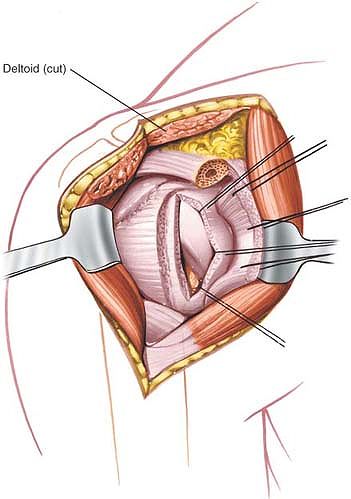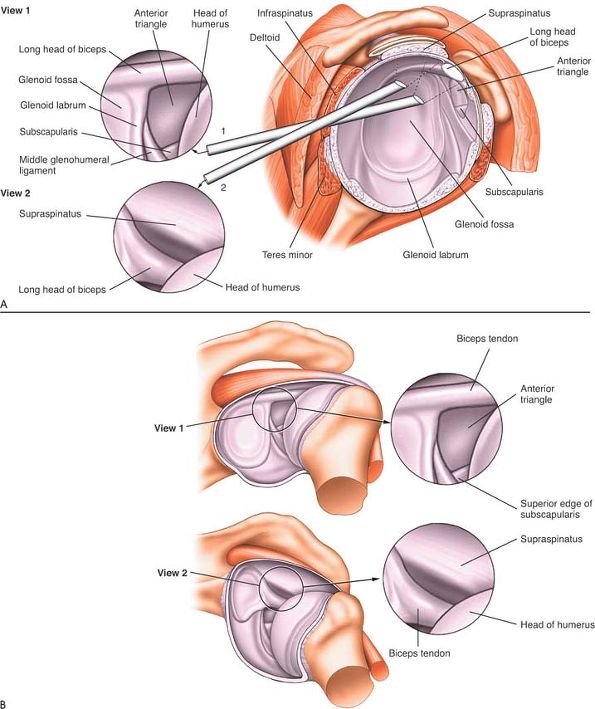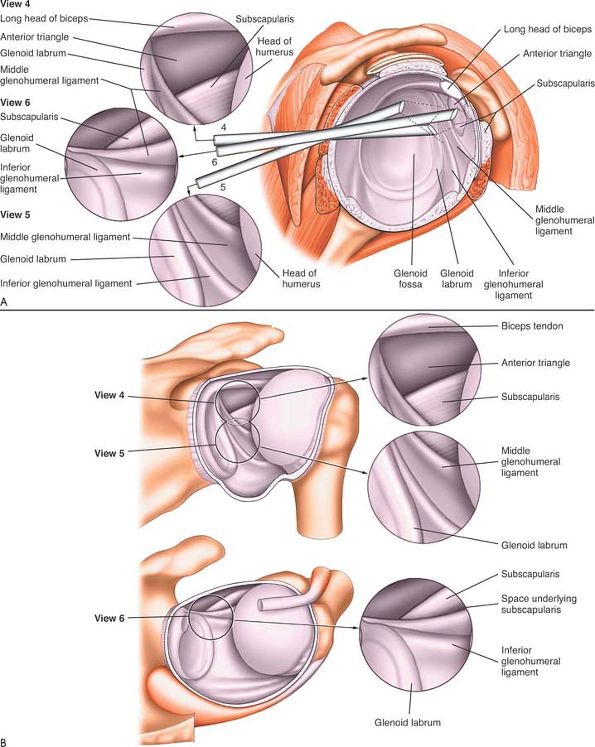The Shoulder
surrounded by two sleeves of muscle: the outer sleeve, or deltoid
muscle; and the inner sleeve, or rotator cuff, which is critical for
the stability of the joint. The two most common shoulder pathologies
that necessitate surgery are instability, such as recurrent anterior
dislocation of the shoulder (see Fig. 1-29), and degenerative lesions of the rotator cuff.
anterior and posterior approaches to the shoulder, anterolateral
approach to the acromioclavicular joint and subacromial space, anterior
approach to the clavicle, lateral and minimal access lateral approach
to the proximal humerus, and two arthroscopic approaches—anterior and
posterior. Of these, the anterior approach is the “work-horse” incision
of the shoulder, providing excellent exposure of both the joint and its
anterior coverings. The anterolateral approach is used mainly to expose
the acromioclavicular joint and subacromial structures, especially the
rotator cuff. The lateral approach and minimal access lateral approach
also expose the rotator cuff but their main use is in the treatment of
fractures of the proximal humerus. The posterior approach, which is
used rarely, is effective in treating recurrent posterior dislocations
and is also used for open reduction and internal fixation of fractures
of the posterior glenoid and fractures of the scapula neck. The
arthroscopic approaches to the shoulder (anterior and posterior)
provide excellent visualization of the internal structures of the joint.
sections: anterior, anterolateral, and posterior. A description of each
area is found immediately after its respective operative section in
this chapter.
-
Open reduction and internal fixation of fractures
-
Reconstruction of the sternoclavicular and the acromioclavicular joints in case of dislocation
-
Drainage of sepsis
-
Biopsy and excision of tumors
-
Osteotomy for malunion
approached via this surgical approach. Osteotomy of the clavicle is
required (see page 16, Fig. 1-20).
platysma muscle is very common. Because of the proximity of great
vessels, such superficial bleeding must be controlled to ensure
adequate visualization of the structures.
the table and elevate the head end, so as to elevate the shoulder area.
Place a sandbag between the medial border of the scapula and the spine.
This will allow the shoulder to drop back and often this maneuver
reduces fractures of the middle third.
incision. From the sternal notch, palpate the clavicle laterally to the
acromioclavicular joint, palpating the subcutaneous surface of the
clavicle.
anatomy, beginning from the medial end. The site and length of the
incision depends on the clinical indication for surgery (Fig. 1-1).
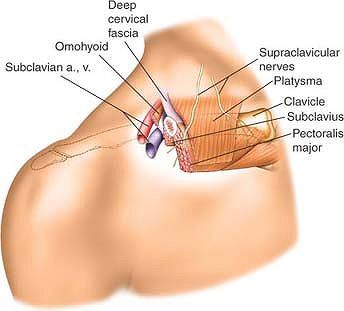 |
|
Figure 1-1
Make a longitudinal incision overlying the subcutaneous surface of the clavicle. The site and length of the incision are determined by the pathology to be treated and the implant to be used. |
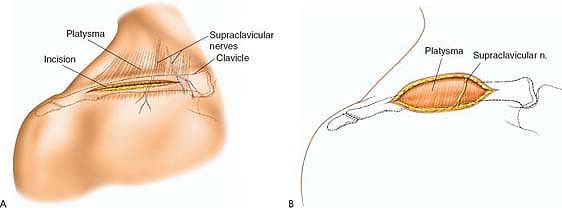 |
|
Figure 1-2 (A)
Deepen the incision in the line of the skin incision to expose the platysma muscle. Note the presence of several cutaneous nerves. (B) Deepen the incision through the platysma muscle in the line of the skin incision to expose the subcutaneous surface of the clavicle. |
surface of the clavicle, there is no internervous plane. However, the
incision cuts across numerous small subcutaneous nerves, which cross
the operating field from superior to inferior running in the substance
of the platysma muscle.
the subcutaneous surface of the clavicle. Take care to diathermy the
numerous vessels present within this muscle (Fig. 1-2).
of the clavicle in an epi-periosteal plane. Take care to preserve as
much soft tissue attachments as possible, particularly in cases of
fracture fixation.
immediately inferior to the clavicle throughout its length, especially
in the middle third (Fig. 1-3). To ensure that
the plexus is uninjured, remain on the subcutaneous surface of the
clavicle. If dissection is required inferior to the bone, develop a
plane between the periosteum of the clavicle and the subclavius muscle.
Also, be aware when drilling for fixation of fractures that penetration
of the bone should be minimized in its inferior surface because of the
close proximity of the nerves and vessels.29
inferior to the clavicle. Avoid dissection inferior to the clavicle, if
possible. Dissection onto the subcutaneous surface and the posterior
surface is safe.
whole length of the clavicle as required (see Extensile Measures in
this chapter).
anterolateral approach to the proximal humerus and mid shaft of the
humerus using the deltopectoral interval (see Fig. 1-20).
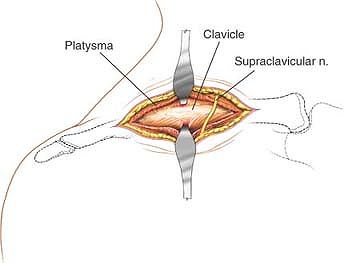 |
|
Figure 1-3 The brachial plexus, the second part of the subclavian vessels, underlie the middle third of the clavicle.
|
of the shoulder joint, allowing repairs to be made of its anterior,
inferior, and superior coverings. Among its many uses, the anterior
approach permits the following:
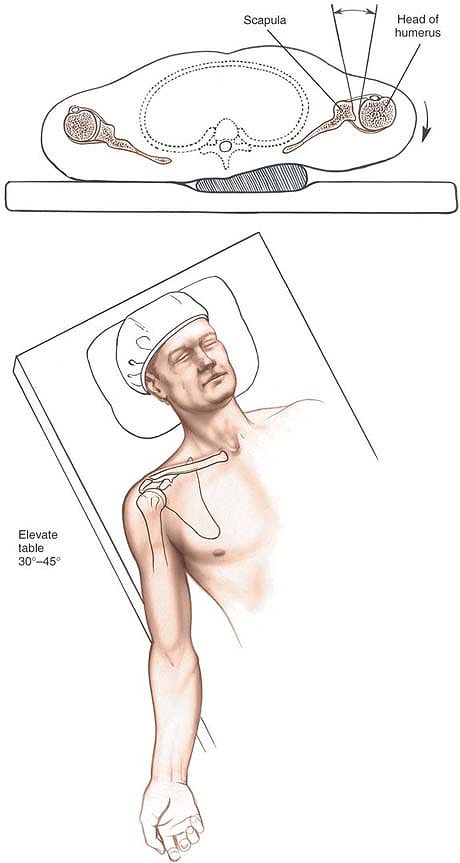 |
|
Figure 1-4
Position of the patient for the anterior approach to the shoulder. Elevate the table to 45°. A sandbag placed under the spine at the medial end of the scapula will allow the shoulder to rotate externally and open the anterior part of the joint. |
-
Reconstruction of recurrent dislocations1,2,3,4,5,6
-
Drainage of sepsis
-
Biopsy and excision of tumors
-
Repair or stabilization of the tendon of the long head of the biceps7
-
Shoulder arthroplasties, which usually are inserted through modified anterior incisions8
-
Fixation of fractures of the proximal humerus
bleeding that occurs from skin and subcutaneous tissues during
superficial dissection. The bleeding must be controlled before the
deeper layers are dissected. Failure to do so may obscure important
anatomic structures and endanger their integrity.
table. Wedge a sandbag under the spine and medial border of the scapula
to push the affected side forward while allowing the arm to fall
backward, opening up the front of the joint (Fig. 1-4).
Elevate the head of the table 30° to 45° to reduce venous pressure, and
thereby decrease bleeding, and to allow the blood to drain away from
the operative field during surgery. If a headrest is used, make sure
that it is padded properly to prevent the development of a pressure
sore on the occiput. Drape the arm free, because it will have to be
moved during the approach. If image intensification is to be used
during surgery, ensure that adequate images can be obtained prior to
prepping and draping the patient.
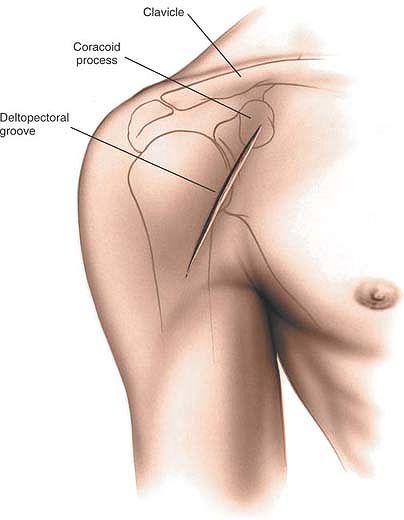 |
|
Figure 1-5 Make a straight incision in the deltopectoral groove, starting at the level of the coracoid process.
|
deepest point in the clavicular concavity, the surgeon should drop his
or her fingers distally about 1 in. from the anterior edge of the
clavicle and press laterally and posteriorly in an oblique line until
the coracoid process is felt. The process faces anterolaterally;
because it lies deep under the cover of the pectoralis major, it can be
felt only by firm palpation.
deltopectoral groove is easier to see than to feel, especially in thin
patients. The cephalic vein, which runs in the groove, sometimes is
visible.
 |
|
Figure 1-6 Make an incision in the axilla. Dissect subcutaneously to mobilize skin.
|
10- to 15-cm straight incision, following the line of the deltopectoral
groove. The incision should begin just above the coracoid process (Fig. 1-5).
the patient supine, abduct the shoulder 90° and rotate it externally.
Mark the anterior axillary skin fold with a sterile pen. Make a
vertical incision 8 to 10 cm long, starting at the midpoint of the
anterior axillary fold and extending posteriorly into the axilla.9
The skin flaps should be undermined extensively with a finger,
especially superiorly in the area of the deltopectoral groove, using
the cephalic vein as a guide to ensure correct position in the vertical
plane. Retract the skin flaps upward and laterally so that the incision
comes to lie over the deltopectoral groove (Figs. 1-6 and 1-7).
advantage over the anterior incision, both because it is hidden in the
axilla and because the resulting scar is covered by hair. In addition,
the suture line remains free from tension while it heals; thus, the
scar has little opportunity to spread. The only situation in which this
incision may be contraindicated is when, in extremely muscular
patients, the skin flaps cannot be moved enough to allow adequate
exposure of the muscular structures that lie in front of the shoulder.
If adequate exposure cannot be obtained through the axillary incision,
it should be extended superiorly into the deltopectoral groove.
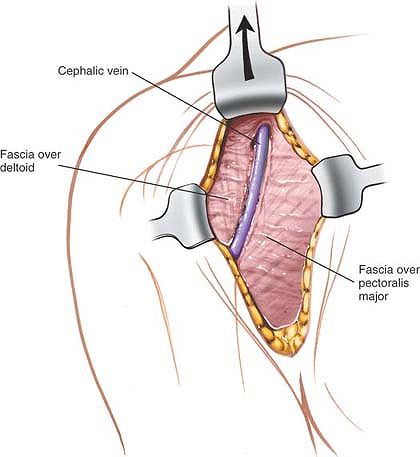 |
|
Figure 1-7 Retract the axillary incision cephalad to expose the cephalic vein and the deltopectoral groove.
|
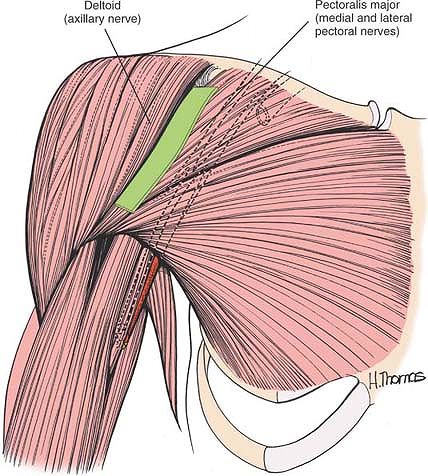 |
|
Figure 1-8
The internervous plane lies between the deltoid muscle (axillary nerve) and the pectoralis major muscle (medial and lateral pectoral nerves). |
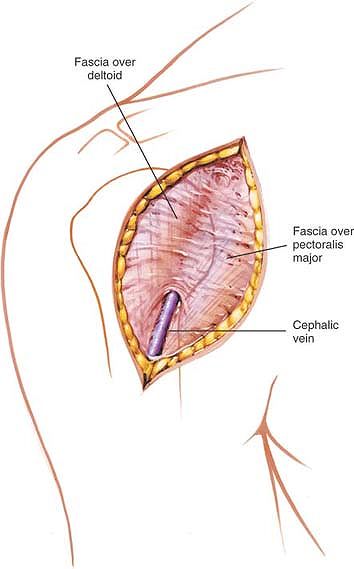 |
|
Figure 1-9
Develop the groove between the fascia overlying the pectoralis major and the fascia overlying the deltoid. The cephalic vein will be of help in locating the groove. |
which is supplied by the axillary nerve, and the pectoralis major
muscle, which is supplied by the medial and lateral pectoral nerves (Fig. 1-8).
Retract the pectoralis major medially and the deltoid laterally,
splitting the two muscles apart. The vein may be retracted either
medially or laterally. Taking a small cuff of deltoid with the vein may
reduce the number of bleeding tributaries that require ligation, but it
leaves a small amount of denervated muscle. For that reason, it is not
recommended as a routine practice.
musculocutaneous nerve) and the coracobrachialis (which is supplied by
the musculocutaneous nerve) must be displaced medially before access
can be gained to the anterior aspect of the shoulder joint. Simple
medial retraction after division of the overlying fascia may be enough
for procedures such as the Magnuson-Stack subscapularis tendon
advancement3 or the Putti-Platt subscapularis2 and capsule imbrication, but if more exposure is necessary, or if the coracoid process is to be transposed,5
the two muscles can be detached with the tip of the coracoid process.
To release them, detach the tip of the coracoid process with an
osteotome. The bone can be replaced later either with a screw or with
sutures. If a screw is used, the coracoid process must be drilled and
tapped before the osteotomy is carried out. Otherwise, the small piece
of coracoid may split during drilling, and anatomic reduction can be
obtained only with extreme difficulty (Figs. 1-10 and 1-11).
brachial plexus, which lie behind the pectoralis minor muscle.
Abduction of the arm causes these neurovascular structures to become
tight and brings them close
to
the tip of the coracoid and the operative site. Therefore, the arm
should be kept adducted while work is being done around the coracoid
process (Fig. 1-12).1
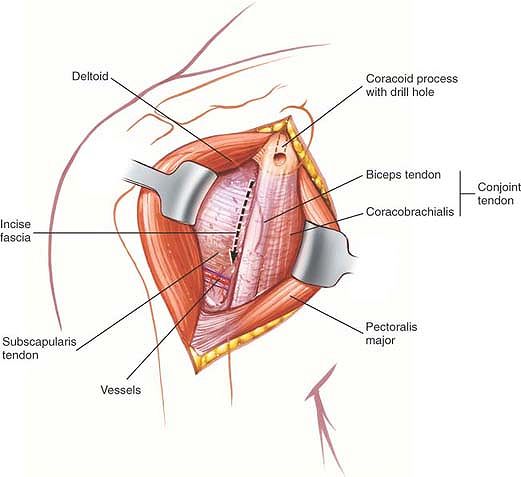 |
|
Figure 1-10
Retract the pectoralis major medially and the deltoid laterally to expose the conjoined tendon of the short head of the biceps and coracobrachialis muscle. Drill the tip of the coracoid process before cutting it. Incise the fascia on the lateral aspect of the conjoint tendon. Note the leash of vessels at the inferior end of the subscapularis muscle. |
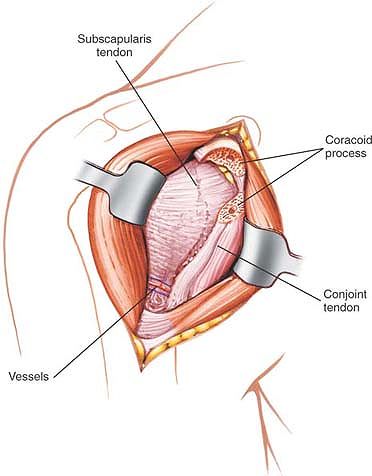 |
|
Figure 1-11
Cut through the predrilled coracoid process. Retract the conjoint tendon medially to give greater exposure to the subscapularis tendon. |
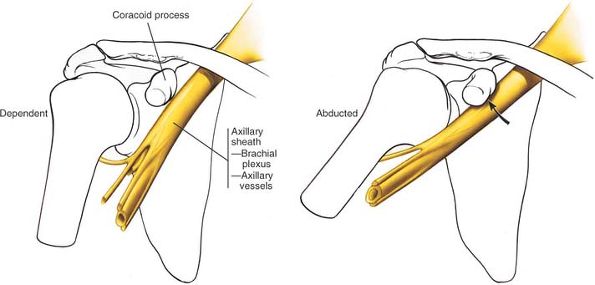 |
|
Figure 1-12
Protect the axillary sheath during coracoid osteotomy by having the arm in the dependent position; abduction of the arm will draw the sheath against the coracoid process. |
medially. Divide the fascia that fans out from the conjoined tendons of
the coracobrachialis and the short head of the biceps on the lateral
side of the coracobrachialis—the safe side of the muscle, because the
musculocutaneous nerve enters the coracobrachialis on its medial side.
Use care in retracting the coracoid with its attached muscles;
overzealous downward retraction can cause a neurapraxia of the
musculocutaneous nerve. If the coracoid process is left intact, the
attached coracoid muscles protect the nerve from traction injury (Fig. 1-13).
and the short head of the biceps lie the transversely running fibers of
the subscapularis muscle, which forms the only remaining anterior
covering of the shoulder joint capsule (Fig. 1-14).1
As the muscle crosses the glenoid cavity, a bursa separates it from the
joint capsule; that bursa may communicate with the shoulder joint. In
cases of multiple anterior dislocations, adhesions often exist between
the muscle and the joint capsule, making it difficult, if not
impossible, to find the layer between the two. Apply external rotation
to the arm to stretch the subscapularis, bringing the muscle belly into
the wound and making its superior and inferior borders easier to
define. External rotation of the humerus also increases the distance
between the subscapularis and the axillary nerve as it disappears below
the lower border of the muscle (see Fig. 1-14).
border of the subscapularis are a series of small vessels that run
transversely and often require ligation or cauterization. The vessels
run as a triad: a small artery with its two surrounding venae
comitantes, one above and one below the artery (Fig. 1-15). The superior border of the subscapularis muscle is indistinct and blends in with the fibers of the supraspinatus muscle.
Tag the muscle belly with stay sutures to prevent it from disappearing
medially when it is cut and to allow easy reattachment of the muscle to
its new insertion onto the humerus. Then divide the subscapularis 1 in
from its insertion onto the lesser tuberosity of the humerus (Fig. 1-16).
Note that some of its muscle fibers insert onto the joint capsule
itself; the capsule frequently may be opened inadvertently when the
muscle is divided, because the two layers cannot always be defined.
identify the insertion of the tendon of the subscapularis onto the
humerus. Detach this insertion with a small flake of bone using a fine
osteotome. This will allow more lateral reattachment of the muscle in a
prepared channel in the bone, using staples.
wherever the selected repair must be performed. Each type of repair has
its own specific location for incision (Fig. 1-17).
by the trauma. Fractures of the greater and lesser tuberosities usually
have their musculo-tenderness insertions preserved and the unopposed
pull of the muscles causes displacement and rotation of the bony
fragments. Attachment of sutures to the tendon allows manipulation and
reduction of the tuberosities. Try to preserve any remaining blood
supply to the head fragment if possible to reduce the risk of avascular
necrosis. The biceps tendon, which runs in the groove between the
greater and lesser tuberosities, is usually preserved and can act as a
key surgical landmark for bony reconstruction.
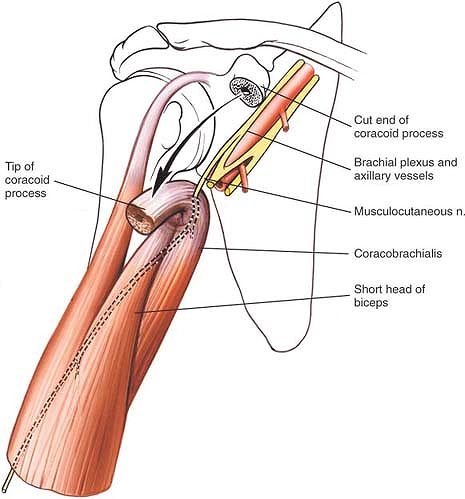 |
|
Figure 1-13 Vigorous retraction of the conjoint tendon distally can injure the musculocutaneous nerve, causing neurapraxia or avulsion.
|
 |
|
Figure 1-14 (A)
The subscapularis muscle lies in the deep part of the wound. It is to be incised perpendicular to its fibers, close to its tendon. The axillary nerve passes anteroposteriorly through the quadrangular space. (B) External rotation of the arm during incision into the subscapularis tendon will draw the point of incision away from the axillary nerve. |
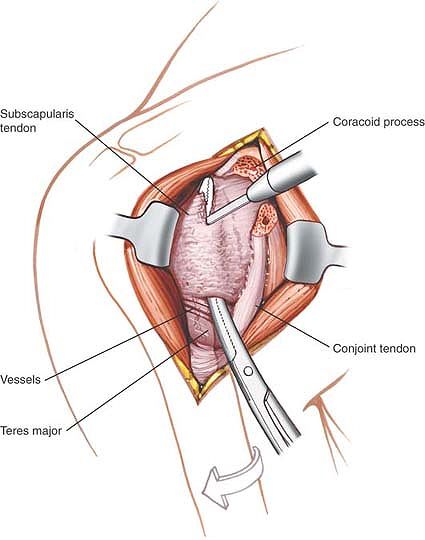 |
|
Figure 1-15
Insert a curved artery clamp under the subscapularis muscle. A leash of vessels at the caudal end of the wound marks the lower border of the subscapularis. |
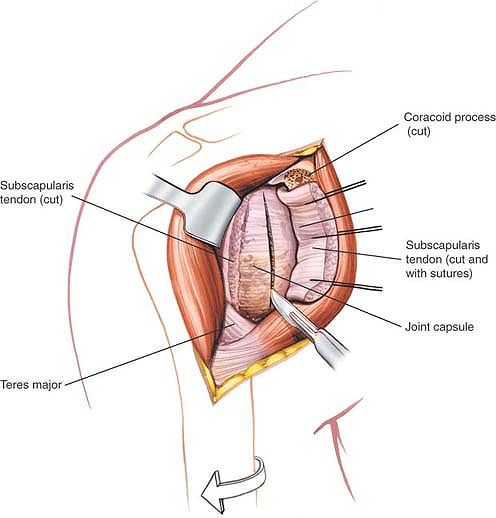 |
|
Figure 1-16
Incise the end of the subscapularis. Tag and place stay sutures into the muscle to prevent it from retracting medially. Some of the subscapularis fibers insert directly into the joint capsule. |
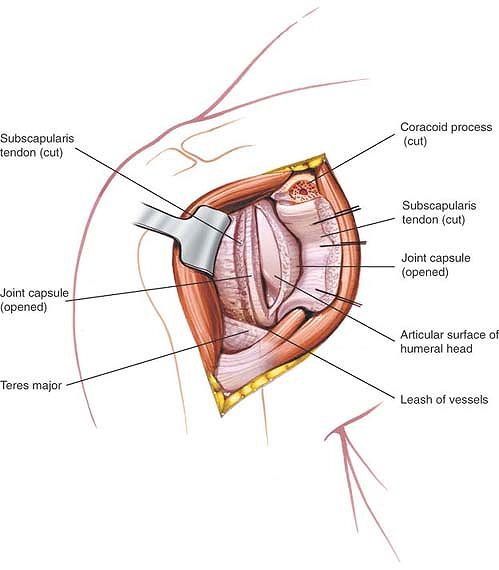 |
|
Figure 1-17 Incise the joint capsule longitudinally to expose the humeral head and the glenoid cavity.
|
enters the body of the coracobrachialis about 5 to 8 cm distal to the
muscle’s origin at the coracoid process. Because the nerve enters the
muscle from its medial side, all dissection must remain on the lateral
side of the muscle. Great care should be taken not to retract the
muscle inferiorly, to avoid stretching the nerve and causing paralysis
of the elbow flexors (see Fig. 1-13).
preserved, if possible, although ligation leads to few problems. A
traumatized cephalic vein should be ligated to prevent the slight
danger of thromboembolism.
-
Extend the skin incision superiorly by
curving it laterally along the lower border of the clavicle. Detach the
deltoid from its origin on the outer surface of the clavicle for 2 to 4
cm to permit better lateral retraction of the muscle (Fig. 1-18).
P.14
Unfortunately, because reattaching the deltoid may be difficult, this
maneuver is not recommended for routine use. If further deltoid
retraction is required, it may be best to detach part of the muscle’s
insertion onto the humerus.![]() Figure 1-18
Figure 1-18
Remove the origins of the deltoid from the anterior portion of the
clavicle to expose the joint further proximally. Identify the
coracoacromial ligament. -
Lengthen the skin incision inferiorly
along the deltopectoral groove to separate the pectoralis major from
the deltoid further inferiorly and to improve the exposure without
having to detach the deltoid origin. -
Use a suitable retractor (such as the
Bankart skid) for the humeral head. A humeral head retractor is the key
to excellent exposure of the inside of the glenoid fossa once the joint
has been opened (Fig. 1-19). -
Rotate the shoulder internally and externally to bring different elements of the anterior shoulder coverings into view.
expose the brachial plexus and axillary artery, and to gain control of
arterial bleeding from the axillary artery, extend the skin incision
superomedially, crossing the middle third of the clavicle. Next,
dissect the middle third of the clavicle subperiosteally and perform
osteotomy of the bone, removing the middle third. Cut the subclavius
muscle, which runs transversely under the clavicle. Retract the
trapezius superiorly and the pectoralis major and pectoralis minor
inferiorly to reveal the underlying axillary artery and the surrounding
brachial plexus (Fig. 1-20). Take care not to damage the musculocutaneous nerve, which is the most superficial nerve in the brachial plexus.
then curve it inferiorly, following the lateral border of the biceps.
Deep dissection consists of moving the biceps brachii medially to
reveal the underlying brachialis, which then can be split along the
line of its fibers to provide access to the humerus. For details of
this approach, see Chapter 2.
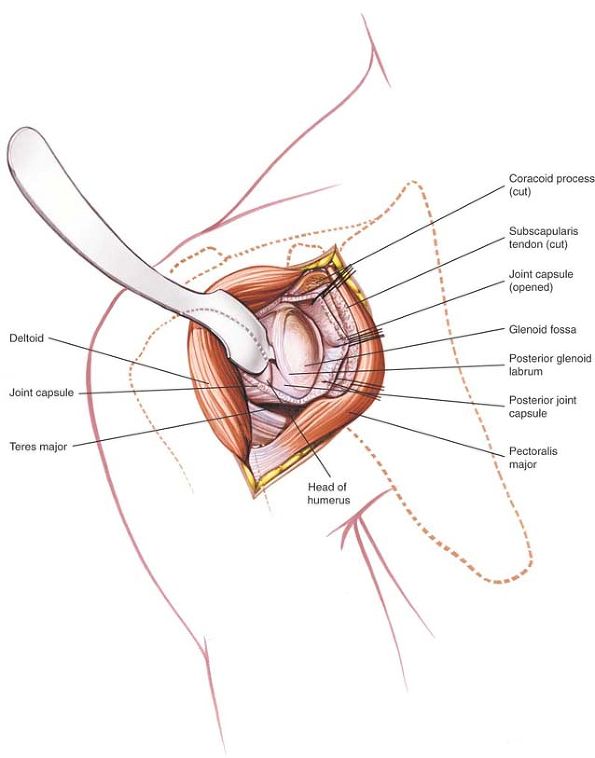 |
|
Figure 1-19 A Bankart skid is used to retract the humeral head to expose the glenoid cavity and its labrum.
|
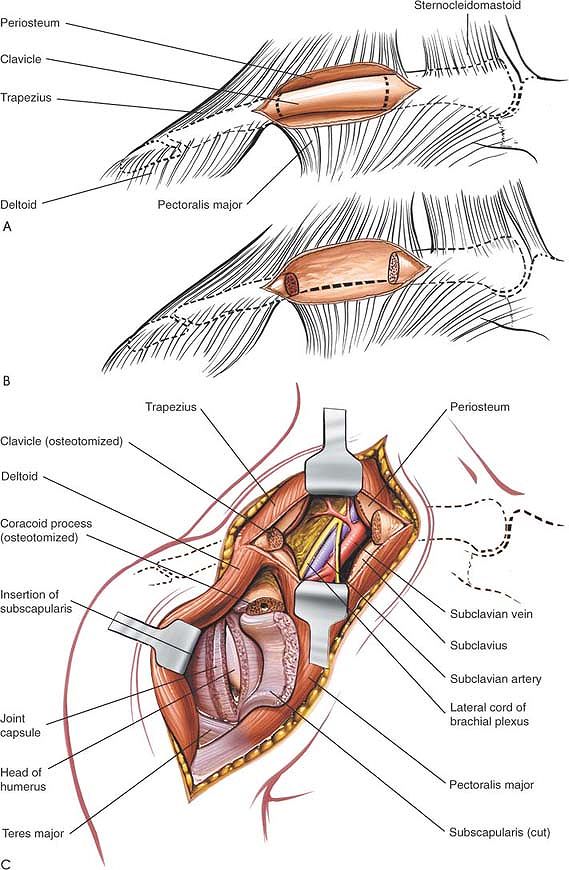 |
|
Figure 1-20 (A, B) Extend the incision superomedially. Expose and resect the middle third of the clavicle subperiosteally. (C) Expose the brachial plexus and axillary artery.
|
two muscular coverings, or sleeves, over the joint. The outer sleeve is
the deltoid muscle. The inner sleeve is the rotator cuff, which
consists of four muscles: the supraspinatus, infraspinatus, teres
minor, and subscapularis (Fig. 1-21).
involves reflecting the outer sleeve laterally and incising the inner
sleeve, specifically the subscapularis.
latissimus dorsi (the two great muscles of the axillary fold), supplies
most of the power that is required for shoulder movement. The muscles
of the inner sleeve all can act as prime movers of the humerus, but
their most important action is to control the humeral head within the
glenoid cavity while the other muscles are carrying out major movements.
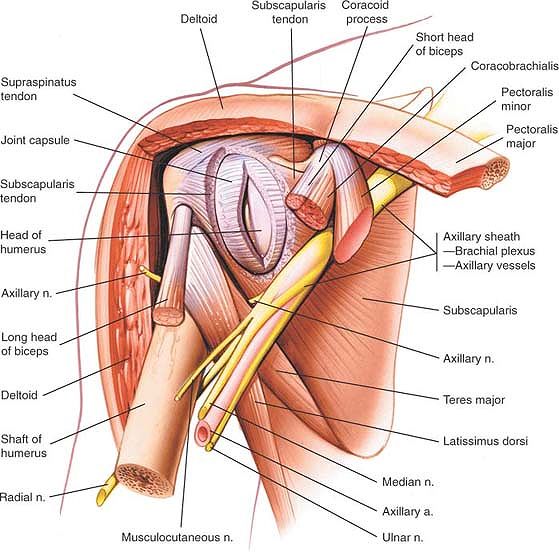 |
|
Figure 1-21 Anatomy of the anterior portion of the shoulder.
|
humerus in initiating abduction. The teres minor and infraspinatus
muscles are the only important external rotators of the shoulder.
Pathology of this joint nearly always is associated with this inner
group of muscles; their function is critical not only to the
coordination of joint movement, but also to the stability of the
shoulder joint itself. Degenerative lesions of the rotator cuff are
extremely common with increasing age.
the soft tissue attachments of elements of the rotator cuff to the
greater and lesser tuberosities.
muscular sleeves when the joint is approached from the front. These
muscles (the short head of the biceps, the coracobrachialis, and the
pectoralis minor)
require medial retraction for exposure of the inner sleeve. They all are attached to the coracoid process (see Fig. 1-21).
is an accessible bony protuberance that lies at the upper end of the
deltopectoral groove and is the landmark for incisions based on that
groove. It also is a critical landmark for injections and arthroscopic
examinations of the shoulder joint. Hook shaped, the coracoid process
sometimes is described as resembling a crow’s beak, as is implied by
its name, corax. The tip of the coracoid process projects forward,
laterally, and inferiorly toward the glenoid cavity. Therefore, it is
palpated best by posterior and medial pressure. Be aware that palpation
of the coracoid process often is painful; therefore, tenderness over
this site is not diagnostic of local pathology. Attached to the
coracoid process are the five clinically important structures described
below (Fig. 1-22).
The tough, fibrous coracoacromial ligament is triangular and connects
the horizontal portion of the coracoid process to the tip of the
acromion. It is one of the few ligaments that connects two parts of the
same bone. The coracoid process, the acromion, and the coracoacromial
ligament form the coracoacromial arch. This structure may be implicated
in the pathology of the impingement syndrome. The function of the
coracoacromial ligament is unclear. Resection of the coracoacromial
ligament, which is frequently carried out in subacromial decompression,
does not appear to be associated with significant long-term clinical
problems.
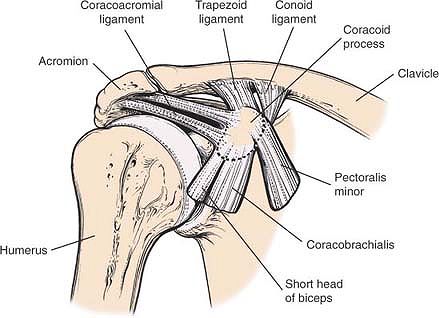 |
|
Figure 1-22 Five clinically important structures are attached to the coracoid process.
|
The conoid and trapezoid ligaments are extremely strong. The conoid
ligament, which resembles an inverted cone, extends upward from the
upper surface of the clavicle. The trapezoid ligament runs from the
upper surface of the coracoid process and extends superiorly and
laterally to the trapezoid ridge on the undersurface of the clavicle.
These two structures are the main accessory ligaments of the
acromioclavicular joint. They are extremely difficult to repair in
cases of acromioclavicular dislocation and, once they are torn, are
difficult to identify as individual structures.
groove cuts almost transversely across the cleavage lines of the skin,
it often leaves a broad scar, even if a subcuticular skin closure is
used. An incision in the axilla runs with the cleavage line of the skin
and leaves a much narrower scar. The latter scar is almost invisible,
because it is hidden in the axillary fold and is covered by hair.
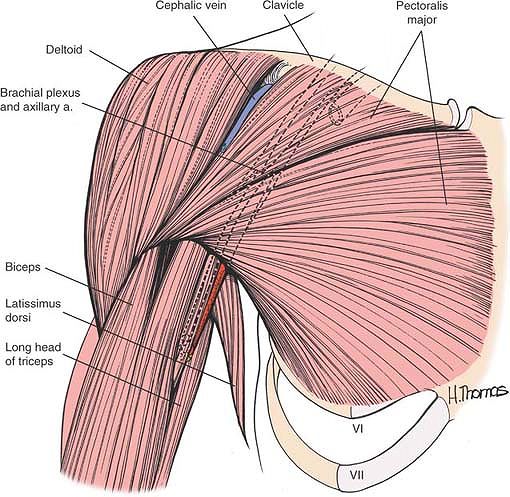 |
|
Figure 1-23 The superficial anatomy of the anterior shoulder, revealing the deltopectoral groove and the neurovascular bundle.
|
surgical dissection of the anterior approach to the shoulder joint: the
deltoid muscle laterally, the pectoralis major muscle medially, and the
cephalic vein, which lies between them in the deltopectoral groove (Fig. 1-23).
to each other, without fibrous septa between them. Because sutures
placed in this kind of muscle fiber tend to tear out, it is difficult
to reattach the deltoid to the clavicle. Sutures must be placed through
the full thickness of the muscle, including its fascial coverings, to
effect a strong reattachment. The attachment should be protected from
active stress for 4 weeks to allow for adequate healing.
only if the entire anterior part of the muscle is stripped and
retracted vigorously in a lateral direction (Fig. 1-24).
muscle to be split without the loss of innervation to either part,
making possible muscle transfers such as the Clark procedure, in which
the distal part of the muscle is separated from the proximal part and
is inserted into the biceps tendon in the arm (see Fig. 1-24).10
passing through the clavipectoral fascia. On occasion, it may be
absent. Few complications result from its ligation (see Fig. 1-23).
brachii share a common origin from the tip of the coracoid process.
They also share a common nerve supply, the musculocutaneous nerve.
These muscles form an intermediate layer during the surgical approach (Fig. 1-25).
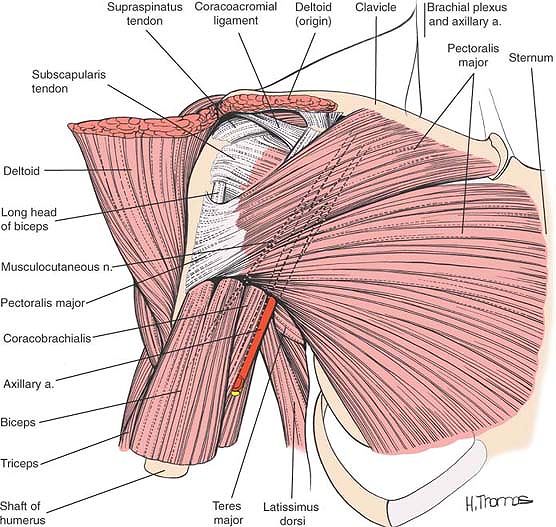 |
|
Figure 1-24
The anterior portion of the deltoid has been resected from its origin, revealing the insertion of the pectoralis major muscle and the subscapularis tendon, supraspinatus tendon, and coracoacromial ligament. |
little function. Extremely variable in size, it is the counterpart in
the arm of the adductors in the thigh.
The musculocutaneous nerve passes between two of the original heads,
which now are fused during development. Its course represents one of
the few instances in which a nerve appears to pass through a muscle.
When a nerve does this, it always is passing between two heads of
origin (see Fig. 1-25).
curiosity; it is one of only two tendons to pass through a synovial
cavity. The joint capsule of the shoulder is incomplete inferiorly, so
the tendon can escape under the transverse ligament. From there, it
runs in the bicipital groove of the humerus. It is easy to palpate the
tendon in the groove as long as the arm is rotated externally (see Fig. 1-27).
The biceps tendon is a common site of inflammatory changes, partly
because it is capable of tremendous excursion, moving some 6 cm between
full abduction and full adduction of the shoulder. This continual
movement may produce attrition between the tendon and the bicipital
groove. The tendon also may rupture, producing a characteristic change
in the contour of the muscle.
medial walls may be predisposed to such tendon dislocation.
Nevertheless, the transverse humeral ligament (retinaculum), which is
the chief stabilizer for the tendon, must be ruptured before the tendon
can be displaced. The tendon is a useful surgical landmark in the
reconstruction of complex proximal humeral fractures.
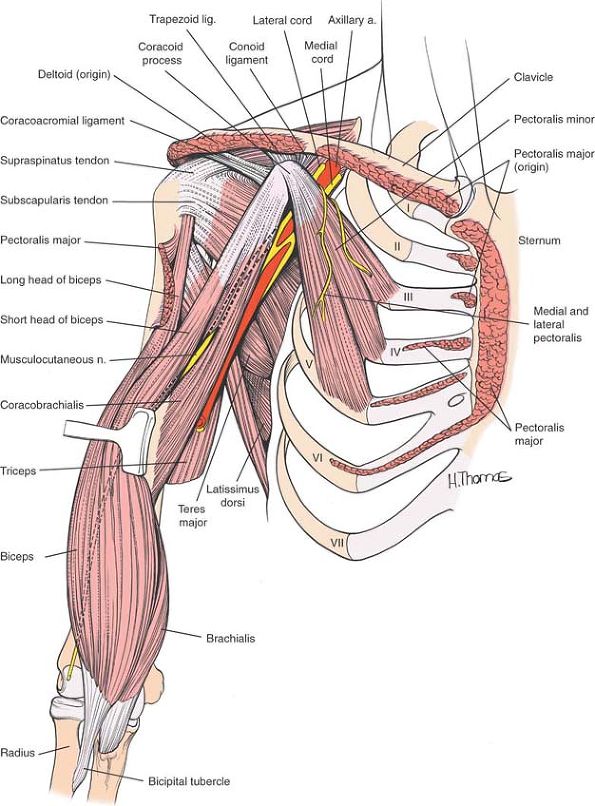 |
|
Figure 1-25
The pectoralis major and deltoid muscles have been removed completely, revealing the two heads of the biceps tendon, the rotator cuff, the coracoacromial ligament, and the neurovascular bundle. |
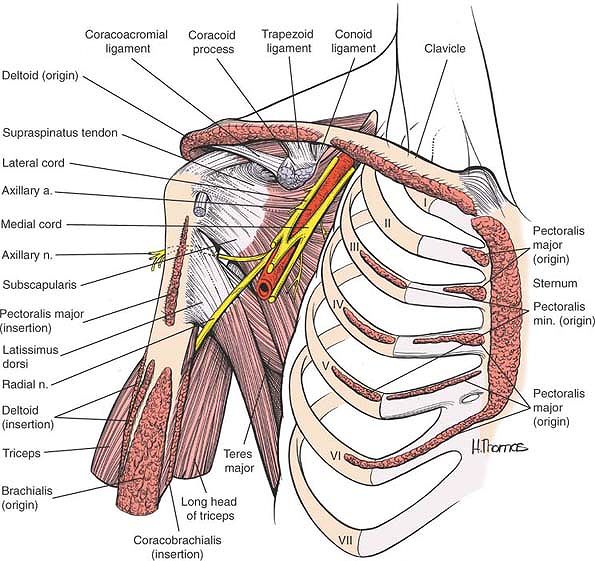 |
|
Figure 1-26
The neurovascular bundle lying on the subscapularis is revealed. The axillary nerve exists through the quadrangular space, and the radial nerve exists through the triangular space. Deltoid. Origin. Anterior border of lateral third of clavicle. Outer border of acromion and inferior lip of crest of scapular spine. Insertion. Deltoid tubercle of humerus. Action. Abduction of shoulder. Anterior fibers act as flexors of shoulder; posterior fibers act as extensors of shoulder. Nerve supply. Axillary nerve.
Pectoralis Major. Origin.
From two heads. Clavicular head: from medial half of clavicle. Sternocostal head: from manubrium and body of sternum, upper six costal cartilages, and aponeurosis of external oblique. Insertion. Lateral lip of bicipital groove of humerus. Action. Adduction of arm. Nerve supply. Medial and lateral pectoral nerves. (A separate branch of the lateral pectoral groove supplies the clavicular fibers.) Coracobrachialis. Origin. Tip of coracoid process. Insertion. Middle of medial border of humerus. Action. Weak flexor of arm and weak adductor of arm. Nerve supply. Musculocutaneous nerve.
Biceps Brachii. Origin. Short head from tip of coracoid process. Long head from supraglenoid tubercle of scapula. Insertion. Bicipital tuberosity of radius. Action. Flexor of elbow. Supinator of forearm. Weak flexor of shoulder. Nerve supply. Musculocutaneous nerve.
Pectoralis Minor. Origin. Outer borders of third, fourth, fifth, and sixth ribs. Insertion. Coracoid process of scapula. Action. Lowers lateral angle of scapula. Protracts scapula. Nerve supply. Medial pectoral nerve.
|
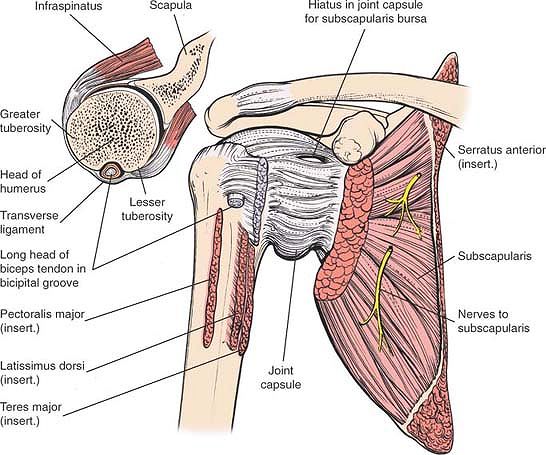 |
|
Figure 1-27
The fibrous joint capsule inserts into the humerus around the articular margin of the neck. Inspect inferiorly where it inserts below that articular margin. The capsule bridges the gap across the bicipital groove, forming a structure known as the transverse ligament. Subscapularis. Origin. Medial four fifths of anterior surface of scapula. Insertion. Lesser tuberosity of humerus. Action. Internal rotator of humerus. Nerve supply. Upper and lower subscapularis nerves.
|
muscle lies in its neurovascular relations. The second part of the
axillary artery and the cords of the brachial plexus lie directly
behind the muscle and below the coracoid process (see Fig. 1-25).
rotator cuff, inserts partly into the capsule of the joint. The muscle
tendon undergoes degeneration in the same way as do other muscles of
the rotator cuff, but to a lesser extent. The problem rarely is severe
or symptomatic, because there are other internal rotators of the
shoulder and the loss of subscapularis action is not functionally
disabling. The subscapularis may be stretched in cases of anterior
dislocations of the shoulder or it may be contracted as a result of
previous surgery.13
prevent anterior dislocations; it also may block anterior dislocation
physically because of its size and its position in front of the
shoulder joint. Because the two subscapular nerves enter the
subscapularis medially, incising it 2.5 cm from its insertion does not
denervate the muscle (Fig. 1-26).
supraspinatus. The plane of cleavage between the two muscles, which
represents a true internervous plane between the suprascapular and
subscapular nerves, may be difficult to define, especially near the
insertions
of the muscles. The tendon of the long head of the biceps corresponds
to the interval between the muscles and can be used as a surgical
guideline to that interval.
 |
|
Figure 1-28
Cross section of the joint. The joint capsule is redundant inferiorly to allow abduction. The long head of the biceps tendon traverses the joint. The tendon is surrounded by synovium and, therefore, is anatomically intracapsular but extrasynovial. |
capsule is loose and redundant, particularly inferiorly and anteriorly.
The area of the fibrous capsule itself is about twice the surface area
of the humeral head (see Fig. 1-26).
Anteriorly, the capsule is attached to the scapula via the border of
the glenoid labrum and the bone next to it. The anterior part of the
capsule usually has a small gap that allows the synovial lining of the
joint to communicate with the bursa underlying the subscapularis.14,15 This bursa extends across the front of the neck of the scapula toward the coracoid process (Fig. 1-27).
the border of the labrum. A second gap may exist at this point to allow
communication between the synovial lining of the joint and the
infraspinatus bursa.
articular margins of the neck, except inferiorly, where the insertion
is 1 cm below the articular margin. The capsule bridges the gap across
the bicipital groove, forming a structure known as the transverse
ligament. The long head of the biceps enters the joint beneath this
ligament (see Fig. 1-27).
all four muscles of the rotator cuff. Further reinforcement is provided
by the three glenohumeral ligaments, which appear as thickenings in the
capsule. These ligaments are extremely difficult to identify during
open surgery, but are usually obvious in arthroscopic procedures. They
appear to be of no clinical relevance (see Figs. 1-78A and 1-80A).
glenoid labrum, lines the capsule of the joint. The membrane usually
communicates with the subscapularis bursa and, occasionally, with the
infraspinatus bursa (see Figs. 1-27 and 1-39).
It envelopes the tendon of the long head of the biceps within the
shoulder joint. The synovium forms a tubular sleeve that permits the
tendon to glide back and forth during abduction and adduction of the
arm. Therefore, the tendon is anatomically intracapsular, but
extrasynovial (Fig. 1-28 and see Fig. 1-39).
The joint capsule attaches to it superiorly, inferiorly, and
posteriorly. Anteriorly, the attachment depends on the presence or
absence of the synovial recess running across the scapular neck
(subscapularis bursa; see Fig. 1-39);
the presence of the synovial recess leaves a gap in the attachment of the glenoid to the scapula (see Fig. 1-27).
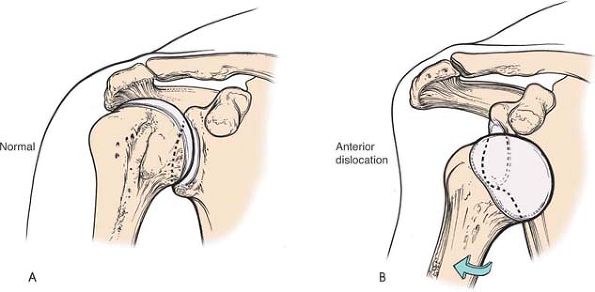 |
|
Figure 1-29 (A) The normal relationship of the humerus to the glenoid cavity. (B) Anterior dislocation of the humerus.
|
that creates the Bankart lesion in cases of recurrent anterior
dislocation of the shoulder (Fig. 1-29).
is a branch of the lateral cord of the brachial plexus. It supplies the
coracobrachialis, biceps brachii, and brachialis muscles, and
terminates as the upper lateral cutaneous nerve of the forearm (see Figs. 1-13 and 1-25).
the muscle from its medial side about 8 cm below the tip of the
coracoid process. The nerve rarely is cut during surgery, but a
neurapraxia resulting from excessive retraction can occur.
becomes the most superficial nerve structure in the axillary bundle.
Therefore, it is the most common nerve structure to be injured in types
of trauma, such as fractures of the clavicle. Care should be taken not
to overpenetrate the inferior cortex of using a drill on the superior
surface of the clavicle.
lies inferior to the coracoid process under cover of the pectoralis
minor muscle. It may be damaged if the arm is not kept adducted while
work is being performed on the coracoid process (see Figs. 1-12 and 1-26).
excellent exposure of the acromioclavicular joint and the underlying
coracoacromial ligament and supraspinatus tendon. Its uses include the
following:
-
Anterior decompression of the shoulder16
-
Repair of the rotator cuff
-
Repair or stabilization of the long head of a biceps tendon
-
Excision of osteophytes from the acromioclavicular joint
reduced the use of this approach in the treatment of impingement
syndrome and for some cases of
rotator
cuff repair. The approach, however, remains clinically relevant in
large numbers of cases involving extensive degenerative disease of the
rotator cuff.
operating table, with a sandbag under the spine and medial border of
the scapula to push the affected side forward (see Fig. 1-4).
Elevate the head of the table 45°. Apply surgical drapes in such a way
that the limb can be moved easily during the operation. This allows
different structures to be brought into view.
the coracoid process 1 in from the anterior end of the clavicle just
inferior to the deepest point of the clavicular concavity.
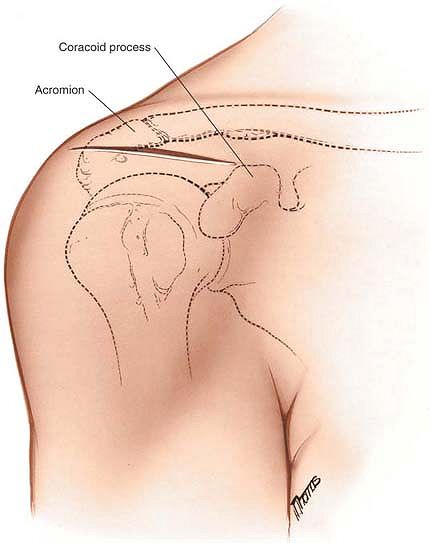 |
|
Figure 1-30 Make a transverse incision beginning at the anterolateral corner of the acromion, ending just lateral to the coracoid process.
|
anterolateral corner of the acromion and ends just lateral to the
coracoid process (Fig. 1-30).
muscle is detached at a point well proximal to its nerve supply, which,
therefore, is not in danger.
deep fascia. Numerous small vessels will be divided. Coagulate these
meticulously to ensure adequate visualization of the deeper structures.
Incise the deep fascia in the line of the skin incision (Fig. 1-31).
Palpate the acromioclavicular joint. If the approach is to be used for
a subacromial decompression and access to the rotator cuff is not
required, detach the fibers of the deltoid that arise from the
acromioclavicular joint and continue this detachment by sharp
dissection laterally to expose 1 cm of the anterior aspect of the
acromion (Fig. 1-32).
Bleeding will be encountered during this dissection as a result of the
division of the acromial branch of the coracoacromial artery. This must
be coagulated. Do not detach more of the deltoid than is necessary
because reattachment is difficult and extensive stripping of the
deltoid from the acromion may be associated with poor long-term results
of surgery.
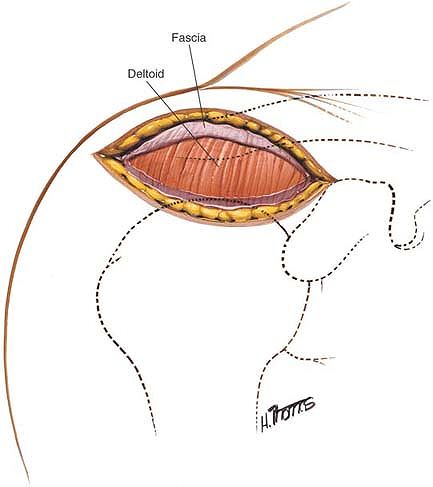 |
|
Figure 1-31 Incise the deep fascia in the line of the skin incision to reveal the underlying deltoid muscle.
|
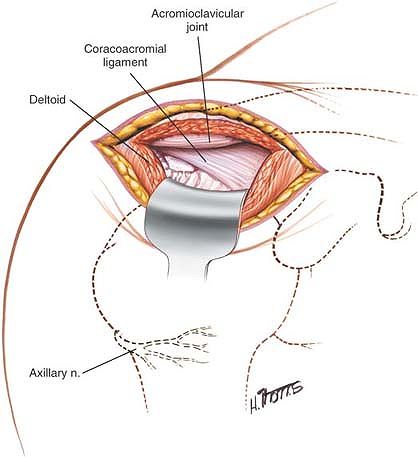 |
|
Figure 1-32 Detach the deltoid from the acromioclavicular joint and 1 cm of the anterior aspect of the acromion.
|
cuff, split the deltoid muscle in the line of its fibers starting at
the acromioclavicular joint. Extend this split 5 cm down from the
acromioclavicular joint (Fig. 1-33). Insert
stay sutures in the apex of the split to prevent the muscle from
splitting inadvertently further down during retraction and damaging the
axillary nerve. Continue the dissection as for subacromial
decompression by detaching the fibers of the deltoid that arise from
the acromioclavicular joint, and, as before, continue this detachment
by sharp dissection laterally to expose 1 cm of the anterior aspect of
the acromion. Retract the split edges of the deltoid muscle to reveal
the underlying coracoacromial ligament.
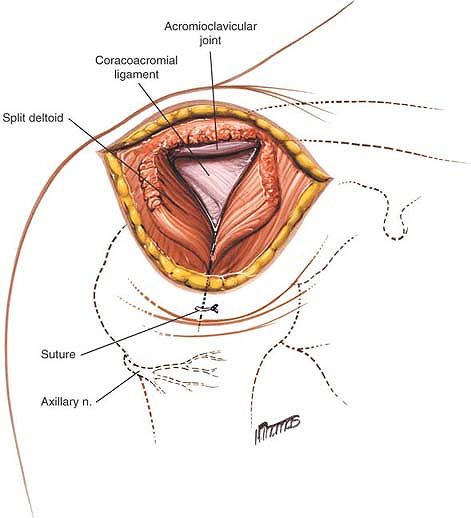 |
|
Figure 1-33 Split the deltoid muscle in the line of its fibers for 5 cm.
|
either by sharp dissection or by removing it with a block of bone from
the undersurface of the acromion. Detach the medial end of the
coracoacromial ligament just proximal to the coracoid process and
excise the ligament. The supraspinatus tendon with its overlying
subacromial bursa now is revealed. Rotate the head of the humerus to
expose different portions of the rotator cuff (Fig. 1-34). Full external rotation will reveal the long head of the biceps tendon in its groove.
transversely across the deep surface of the deltoid muscle about 7 cm
below the tip of the acromion. Splitting the deltoid below this level
may damage the nerve. Inserting the stay suture in the apex of the
deltoid split will prevent this possibility.
 |
|
Figure 1-34
Resect the coracoacromial ligament with a block of bone from the undersurface of the acromion to reveal the underlying subacromial bursa and supraspinatus tendon. |
runs immediately under the deltoid muscle will be divided during the
superficial surgical dissection. Unless bleeding from this site is
controlled, it will be very difficult to identify deeper structures,
which may cause inadvertent deviation from the proper surgical plane.
difficult, extensive detachment of this muscle is not recommended, even
though it does facilitate the exposure.
and surgical neck of the humerus. It is not a classically extensile
approach, because it is limited distally by the traverse of the
axillary nerve over the deep surface of the deltoid muscle. Distal
extension is however possible by utilizing a separate deltoid split
distal to the nerve (see minimal access approach to proximal humerus).
It can be extended usefully in a proximal direction to reveal the
entire length of the supraspinatus muscle. Its use in fracture surgery
is reserved for fractures of the surgical neck and tuberosities of the
humerus. Most distal fractures are best approached through the anterior
approach to the shoulder (see page 7, Fig. 1-8) or the minimal access lateral approach to the proximal humerus (see page 35, Fig. 1-41).
-
Open reduction and internal fixation of displaced fractures of the greater tuberosity of the humerus
-
Open reduction and internal fixation of humeral neck fractures
-
Removal of calcific deposits from the subacromial bursa
-
Repair of the supraspinatus tendon
-
Repair of the rotator cuff
arm at the edge of the table. Elevate the head of the table to reduce
venous pressure and operative bleeding (Fig. 1-35).
A sandbag should be placed under the patient’s shoulder. Ensure that
adequate intraoperative imaging can be obtained before prepping and
draping the patient.
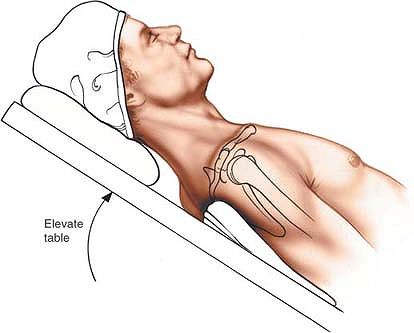 |
|
Figure 1-35
Position of the patient on the operating table for the lateral approach to the shoulder. Elevate the table 45°. Place a sandbag under the shoulder to lift it off the operating table. |
the acromion downward for 5 cm. Insert a suture at the inferior apex of
the split to help prevent it from extending accidentally, with
consequent axillary nerve damage, as the exposure is worked on (Figs. 1-37 and 1-38).
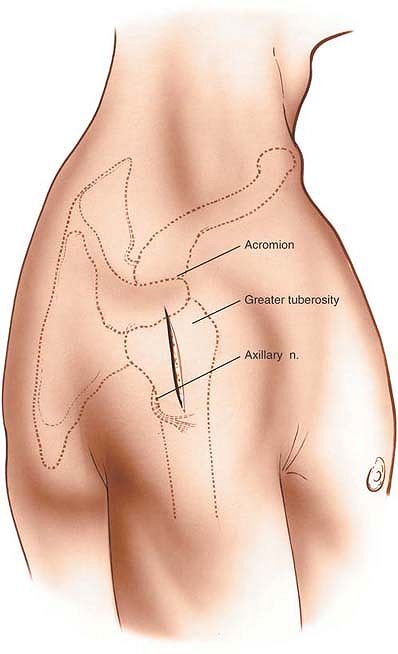 |
|
Figure 1-36 Make a 5-cm longitudinal incision from the tip of the acromion down the lateral aspect of the arm.
|
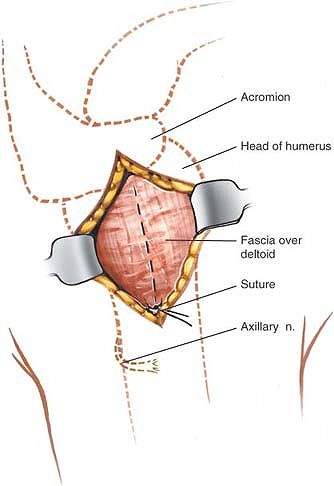 |
|
Figure 1-37
Split the deltoid muscle in line with its fibers and insert a stay suture at the inferior apex of the split to prevent it from extending distally and causing axillary nerve damage. |
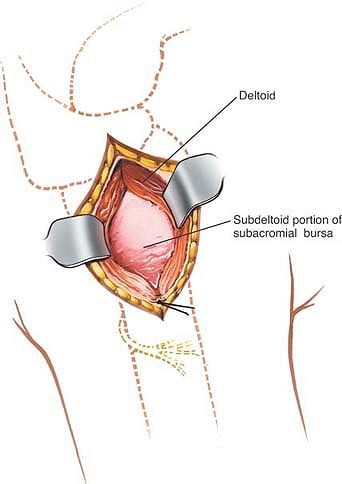 |
|
Figure 1-38 Expose the subdeltoid portion of the subacromial bursa by retracting the deltoid muscle anteriorly and posteriorly.
|
rotator cuff lie directly under the deltoid muscle and the subacromial
bursa (Fig. 1-39). In fractures of the neck of the humerus, the bare ends of bone usually appear at this point without further dissection.
reached through this approach. Most defects in the supraspinatus muscle
are large, however. Some surgical procedures require that the whole
supraspinatus be mobilized so that the muscle can be advanced and the
tendon repaired (Fig. 1-40).
bursa must be incised longitudinally to provide access to the upper
lateral portion of the head of the humerus (see Fig. 1-39).
the posterior wall of the axilla by penetrating the quadrangular space.
Then it winds around the humerus with the posterior circumflex humeral
arteries (see Figs. 1-37 and 1-47).
The nerve enters the deltoid muscle posteriorly from its deep surface,
about 7 cm below the tip of the acromion. From that point, its fibers
spread anteriorly. Because of the nerve’s course, the dissection cannot
be extended farther in an inferior direction without denervating that
portion of the deltoid muscle that is located anterior to the muscle
split.
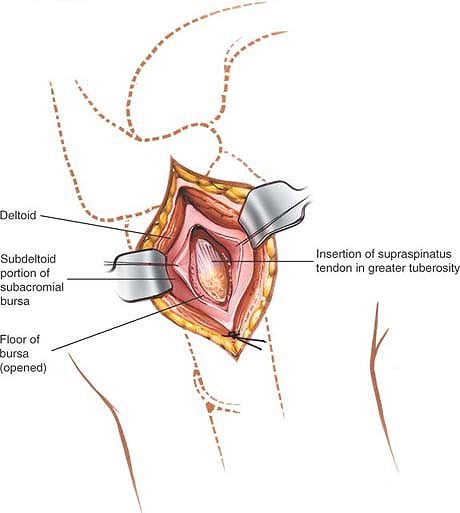 |
|
Figure 1-39 Incise the bursa to reveal the insertion of the supraspinatus tendon into the greater tuberosity.
|
the incision superiorly and medially across the acromion and parallel
to the upper margin of the spine of the scapula, about 1 cm above it
along the lateral two thirds of the scapular spine.17
muscle superiorly to reveal the supraspinatus and its fascial covering.
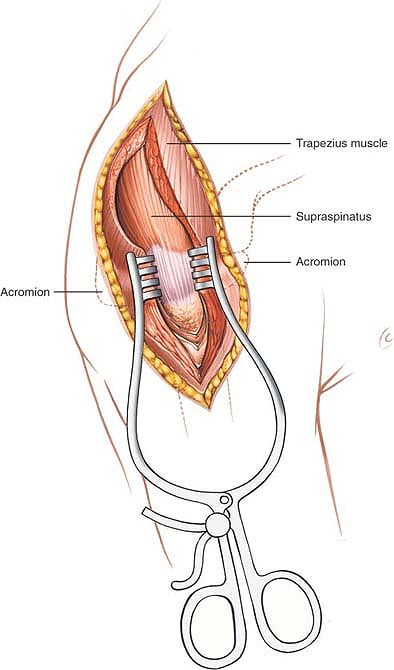 |
|
Figure 1-40
To expose the entire supraspinatus muscle, cut the acromion and split the trapezius muscle to reveal the underlying supraspinatus muscle belly and tendon. The entire muscle can be advanced and the tendon repaired. |
self-retaining retractor. The entire length of the supraspinatus, from
its origin in the supraspinous fossa to its insertion onto the greater
tuberosity of the humerus, now is exposed (see Fig. 1-40 and Fig. 1-48). Take great care to reconstruct the divided acromion during closure.
provides access to the head, surgical neck and proximal third of the
humerus. It utilizes two windows, proximal and distal, on either side
of the axillary nerve as it runs transversally on the under surface of
the deltoid muscle. The use of the lateral minimal access approach is
for internal fixation of displaced fractures of the proximal third of
the humerus. It is of most use in those fractures that have extension
down into the humeral shaft.
same position as for the lateral approach. Ensure that you have
adequate X-ray imaging before prepping and draping (see Fig. 1-35).
6-cm longitudinal incision from the tip of the acromion down the
lateral aspect of the upper arm (see Fig. 1-36). Make a second 5-cm incision distally in the line of the proximal incision (Fig. 1-41).
The position of this second incision will depend on the site of the
fracture and the length of the implant to be used. Accurate positioning
of the distal incision is best achieved by using the image intensifier.
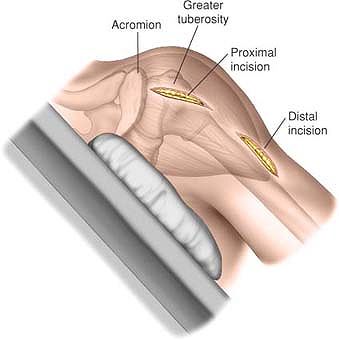 |
|
Figure 1-41
Proximally make a 5- to 6-cm longitudinal incision from the tip of the acromion down the lateral aspect of the upper arm. Distally make an incision in the line of the first incision. The length and position of the distal incision will depend on the pathology to be treated and the implant to be used. |
Carefully split the muscle fibers of the deltoid, but do not extend
this split more than 5 cm distal to the acromion. Deepen the distal
incision through subcutaneous tissue to expose the lateral aspect of
the deltoid muscle (Fig. 1-43).
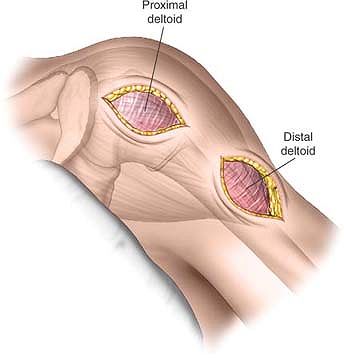 |
|
Figure 1-42 Deepen the incisions through subcutaneous tissue to expose the fascia covering the deltoid muscle.
|
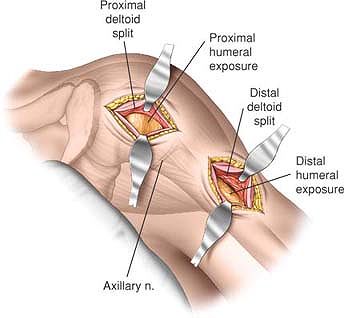 |
|
Figure 1-43
Proximally split the muscle fibers of the deltoid to expose the periosteum overlying the lateral aspect of the proximal humerus. Do not extend this split more than 5 cm distal to the acromion. Distally split the fibers of the deltoid. |
epi-periosteal plane on the lateral surface of the humerus. Using your
finger, carefully palpate the axillary nerve, running on the under
surface of the deltoid (Fig. 1-44). Having
successfully identified the position of the axillary nerve, split the
deltoid in the line of its fibers through the distal incision.
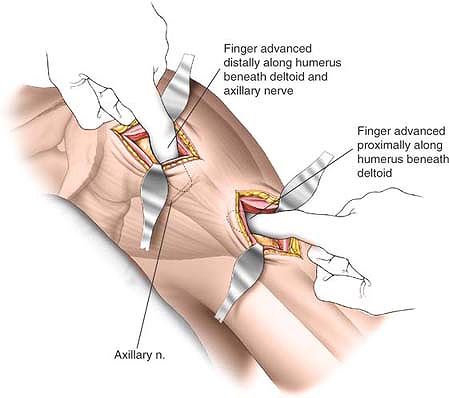 |
|
Figure 1-44
Palpate the axillary nerve as it runs along the undersurface of the deltoid muscle and develop an epi-periosteal plane on the lateral aspect of the humerus, using blunt dissection. |
the bone by gently developing an epi-periosteal plane using your finger
and subsequently the implant (Fig. 1-45).
the under surface of the deltoid. As long as one works beneath the
deltoid on the bone, the nerve will not be injured. Take care, however,
not to aggressively retract the deltoid muscle fibers, either
proximally or distally, as this may induce a traction lesion of the
nerve.
The distal incision can be extended distally to expose the middle third
of the humerus by stripping some of the insertion of the deltoid to the
lateral aspect of the humerus. The distal window cannot be extended
proximally through the substance of deltoid, because this will
inevitably damage the axillary nerve.
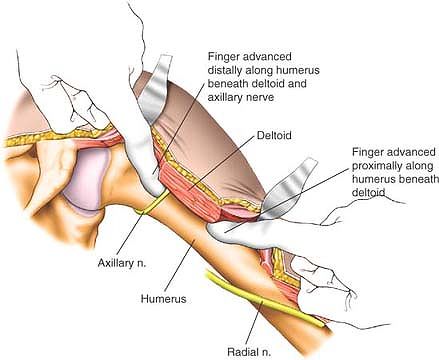 |
|
Figure 1-45 Continue to develop the epi-periosteal plane to connect the two incisions.
|
shoulder joint: the outer sleeve consists of the lateral portion of the
deltoid muscle, and the inner sleeve is the supraspinatus tendon (part
of the rotator cuff) (Figs. 1-46 and 1-47).
lateral continuation of the spine of the scapula, is the summit of the
shoulder, overhanging the greater tuberosity of the humerus. Muscles
either insert onto it or take origin from it, but no muscle crosses it.
Thus, it is partially subcutaneous and can be palpated (see Fig. 1-46). The anatomical shape of the acromion has considerable variation, which may be associated with an impingement syndrome.
cleavage in the skin almost transversely, it is likely to leave a broad
scar.
fibers of the deltoid muscle. Proximal extension of the approach to
expose the supraspinatus involves splitting the fibers of the trapezius
muscle (see Fig. 1-40).
muscle that arises from the lateral border of the acromion. The lateral
deltoid consists of oblique fibers arising in a multipennate fashion
from tough tendinous bands that originate from the acromion. These
bands actually mark the bone with a series of notches. Similar bands
arise from the insertion of the muscle onto the humerus halfway down
the lateral border; the muscle fibers arising from these tendinous
bands interdigitate in a herringbone pattern.
muscle with maximum strength, although it limits the degree to which it
can contract. Nevertheless, despite the arrangement of the fibers, it
is relatively easy to split the muscle in a longitudinal fashion. The
tough tendinous bands also prevent excessive
damage to the muscle when it is split during surgery (Fig. 1-48).
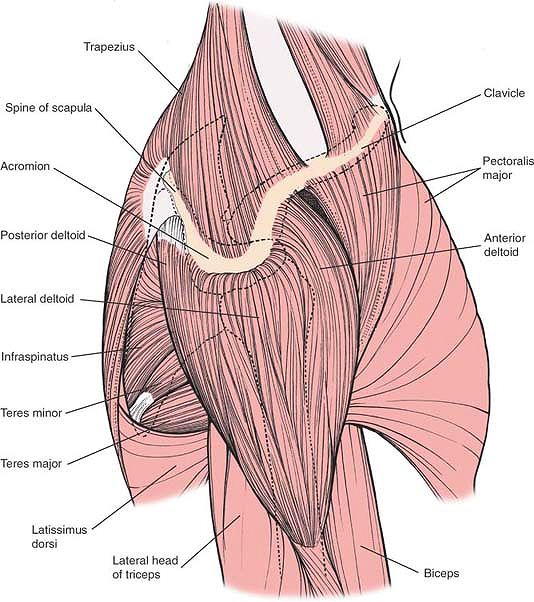 |
|
Figure 1-46
The superficial muscles of the lateral aspects of the shoulder. The muscles take origin from or insert into the acromion and the spine of the scapula, but do not cross them. |
acromion still is in question, because reattachment is difficult and
often unsuccessful.18 An acromial
osteotomy and subsequent reattachment of the bone, with the muscle
still attached to it, may be the best solution, although acromial
nonunion may occur because the anterior and posterior portions of the
deltoid tend to pull apart the site subjected to osteotomy. In the vast
majority of cases, widespread detachment of the deltoid from the
acromion should not be necessary for the adequate exposure of the
underlying structures.
tributary of the acromiothoracic artery, which arises from the second
part of the axillary artery. Running immediately deep to the insertion
of the
deltoid muscle to the acromioclavicular joint, it is coagulated easily.
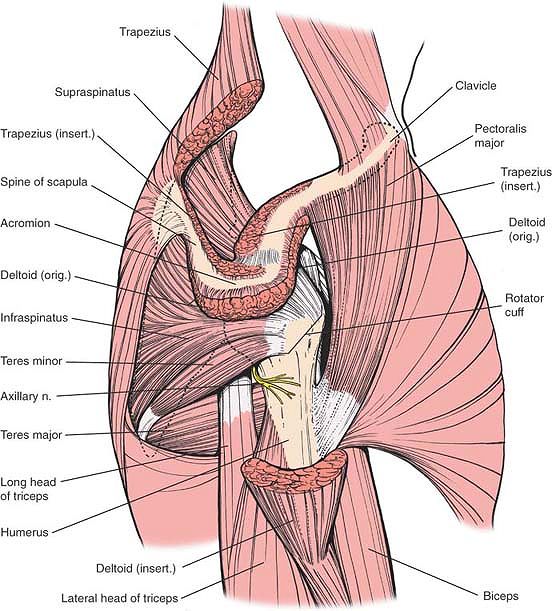 |
|
Figure 1-47
Portions of the deltoid and trapezius have been removed to reveal the underlying rotator cuff and the axillary nerve, usually beneath the teres minor in the quadrangular space. |
muscle that cover the lateral aspect of the shoulder joint. It helps
them glide past each other and protects the rotator cuff (the inner
sleeve) from the hard overlying bone and ligamentous complex—the
acromial process (acromion), the coracoacromial ligament (which spans
the gap between the coracoid process and the acromion), and the
coracoid process of the scapula. Because the bursa lies between the
supraspinatus and deltoid muscles, and between the supraspinatus and
coracoacromial ligaments, it is called both the subacromial bursa and
the subdeltoid bursa (Figs. 1-49 and 1-50).
from beneath the coracoid process. At this point, it provides
lubrication between the conjoined tendons of the coracobrachialis and
biceps brachii muscles, and the underlying subscapularis muscle.
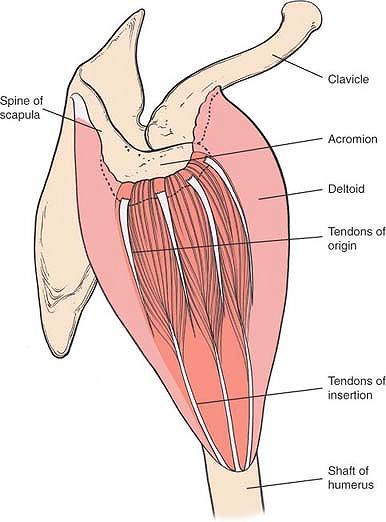 |
|
Figure 1-48 The multipennate arrangement of the muscle fibers of the middle portion of the deltoid muscle.
|
shoulder joint. Rupture of the supraspinatus tendon, however, can cause
the two synovial-lined cavities to join; an arthrogram of the shoulder
can reveal this communication (Fig. 1-51).19,20
under the deltoid muscle and the coracoacromial ligament. When the arm
is abducted, the bursa retreats under the cover of this ligament. At
this point, the patient feels pain if there is inflammation of the
bursa, mainly because the bursa is compressed between the undersurface
of the acromion and the humeral head (Fig. 1-52).
Paradoxically, there is no tenderness on the lateral aspect of the
shoulder in this position, because the bursa now is protected from
palpation completely by the coracoacromial ligament. When the arm is
adducted again, the pain disappears, because the bursa no longer is
compressed between the ligament and the supraspinatus. Tenderness on
palpation may be elicited on the lateral aspect of the shoulder below
the acromion, however, because the bursa now is accessible. Passive
extension of the shoulder also brings the bursa out anteriorly from
beneath the acromion and makes it palpable.
passes laterally beneath the coracoacromial ligament. The muscle is the
frequent site of degenerative changes and frank tears. Degeneration in
its tendon invokes an inflammatory response in the overlying
subacromial bursa, and most cases of subacromial bursitis probably
reflect pathology in the muscle.21
The close relationship of the supraspinatus to the coracoacromial
ligament may result in mechanical abrasion between the two structures
during abduction of the arm, causing degeneration of the tendon. The
subacromial bursa minimizes this tendency (see Figs. 1-50 and 1-54).
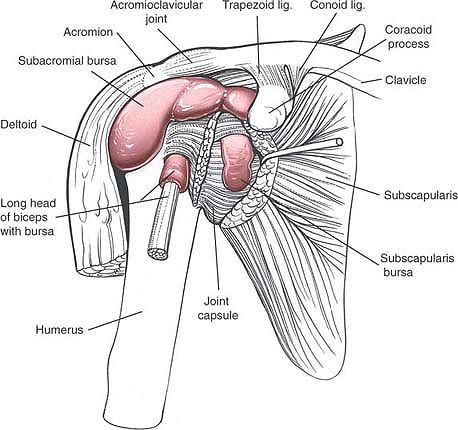 |
|
Figure 1-49
The subacromial bursa. Note the expansion of the subacromial bursa and the large subdeltoid portion. The subscapularis bursa frequently pierces the joint capsule to communicate with the joint. |
tendon takes a 90° turn over the humeral head before its insertion,
putting the blood supply to the tendon on a stretch. Vascular
insufficiency may result, which is another possible cause of
degenerative change.22
fourth of all individuals who reach 65 years of age rupture their
supraspinatus tendon.23 Patients
with complete ruptures of the supraspinatus are unable to abduct their
arms without adopting such trick movements as a shrug mechanism. If
patients with a ruptured supraspinatus lower the affected arm slowly
from the vertical, they lose control of it at about 30° and it drops
suddenly to their side.
of the brachial plexus; it enters the muscle on its deep surface. Some
methods of repairing tears of the supraspinatus tendon involve
mobilizing the entire muscle belly and advancing it laterally to take
tension off the suture line of the repair.17 Take great care in mobilizing the supraspinatus muscle from its fossa, to avoid damaging its nerve (Fig. 1-53).
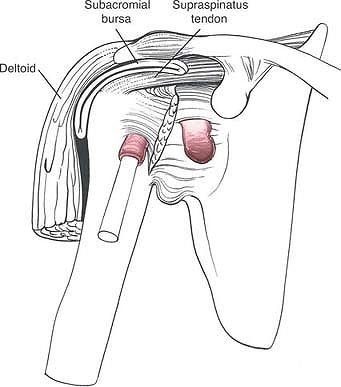 |
|
Figure 1-50 The subacromial bursa directly protects the supraspinatus tendon from the bone and ligamentous complex that covers it.
|
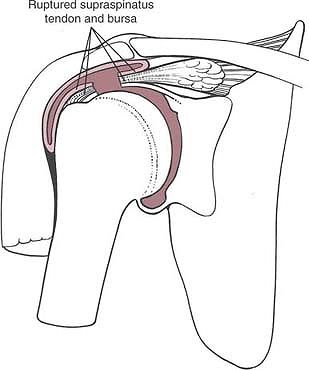 |
|
Figure 1-51
Rupture of the supraspinatus tendon allows direct communication between the joint and the subacromial bursa. An arthrogram of the shoulder will reveal this communication, helping to establish the diagnosis of a torn rotator cuff. |
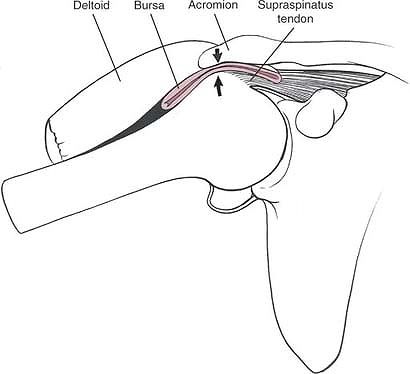 |
|
Figure 1-52
Abduction of the arm can impinge the subacromial bursa between the greater tuberosity and the undersurface of the acromion and coracoacromial ligament. |
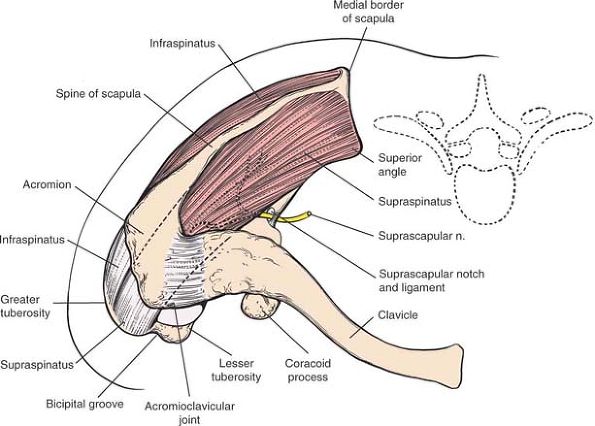 |
|
Figure 1-53
Superior view of the shoulder, showing the rotator cuff and the acromioclavicular joint. The suprascapular nerve supplies the supraspinatus and infraspinatus muscles after passing through the suprascapular notch and ligament. Supraspinatus. Origin. Medial three fourths of supraspinous fossa of scapula. Insertion. Upper facet of greater tuberosity of humerus. Action. Initiates abduction of shoulder. Nerve supply. Suprascapular nerve.
|
between the head of the humerus and the arch created by the acromion
and the coracoacromial ligament. The anatomy of the acromion varies
considerably from individual to individual, and certain acromial shapes
have been associated with an impingement syndrome. Performing an
acromioplasty and cutting the coracoacromial ligament may provide
relief in some patients with impingement syndrome. This procedure can
be carried out by an open operation (see Anterolateral Approach to the
Shoulder) or by arthroscopic techniques.
the lateral end of the clavicle and the medial border of the acromion.
The lateral end of the clavicle is higher than the acromion; the joint
can be palpated by pushing medially against the thickness at the end of
the clavicle.
fibrocartilaginous meniscus, which usually is incomplete; the meniscus
may be displaced during traumatic subluxation of the joint (Fig. 1-54B).
acromioclavicular joint are acromioclavicular dislocations and
acromioclavicular arthritis. In cases of acromioclavicular dislocation,
it is important to remember that the major accessory ligaments of the
joint from the coracoid process to the undersurface of the clavicle are
some distance from it. They cannot be repaired directly to restore
joint stability; however, if the joint is reduced and stabilized by
another technique, they will heal. Acromioclavicular arthritis commonly
is associated
with the development of inferior osteophytes, which are a contributing factor to cases of impingement syndromes.
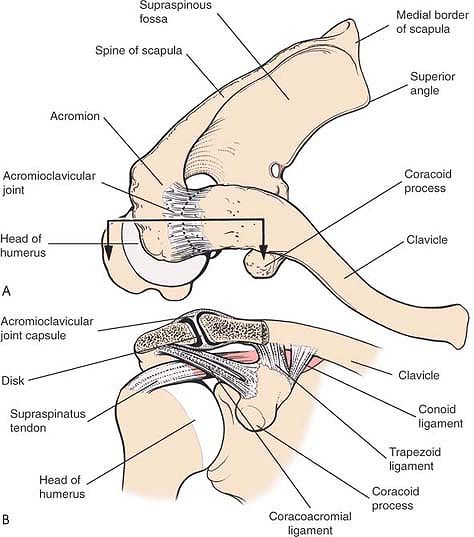 |
|
Figure 1-54 (A) Superior view of the shoulder joint, revealing the bone structure and acromioclavicular joint capsule. (B)
Cross section of anterior view of the shoulder, revealing the acromioclavicular joint and meniscus, as well as the supraspinatus tendon and its relationship to the coracoacromial ligament. |
approach because it is essentially subcutaneous. The insertions of the
trapezius and deltoid muscles to the superior surface of the clavicle
are confluent; however, the two muscles are separated easily by
subperiosteal dissection (Fig. 1-55). In cases
of acromioclavicular dislocation, however, this dissection will have
been done for you and the distal end of the clavicle often lies in a
subcutaneous position.
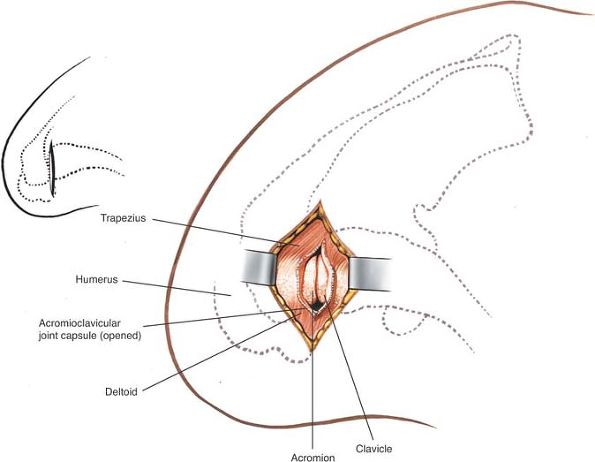 |
|
Figure 1-55 Superior approach to the acromioclavicular joint.
|
-
Repairs in cases of recurrent posterior dislocation or subluxation of the shoulder25,26
-
Glenoid osteotomy27
-
Biopsy and excision of tumors
-
Removal of loose bodies in the posterior recess of the shoulder
-
Drainage of sepsis (the approach allows dependent drainage with the patient in the normal position in bed)
-
Treatment of fractures of the scapula neck, particularly those in association with fractured clavicles (floating shoulder)
-
Treatment of posterior fracture dislocations of the proximal humerus
the operating table with the affected side uppermost. Drape him or her
to allow independent movement of the arm (Fig. 1-56). Stand behind the patient and take care that the ear is not folded accidentally under the head.
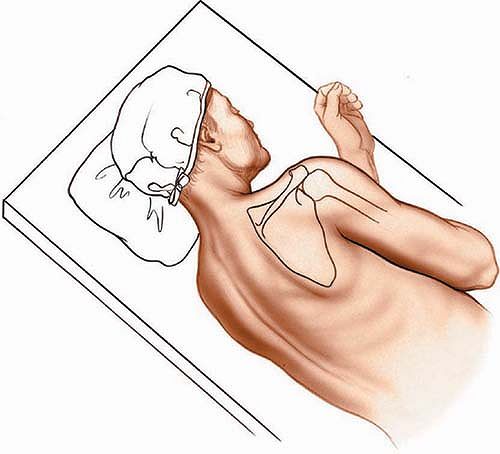 |
|
Figure 1-56
Position of the patient on the operating table for the posterior approach to the shoulder. Drape the involved arm to allow for inde-pendent motion. |
form one continuous arch. The spine of the scapula extends obliquely
across the upper four fifths of the dorsum of the scapula and ends in a
flat, smooth triangle at the medial border of the scapula. It is easy
to palpate.
muscle, which is supplied by the axillary nerve, and the infraspinatus
muscle, which is supplied by the suprascapular nerve (Fig. 1-58).
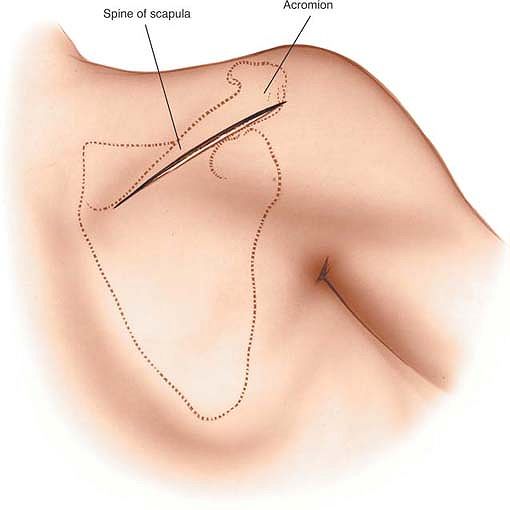 |
|
Figure 1-57
Make a linear incision over the entire length of the scapular spine, extending to the posterior corner of the acromion. You may choose to curve the medial end of the incision distally to enhance the exposure. |
and detach the muscle from this origin. The plane between the deltoid
muscle and the underlying infraspinatus muscle may be difficult to
find, mainly because there is a tendency to look for it too close to
the bone and to end up stripping the infraspinatus off the scapula. The
plane is easier to locate at the lateral end of the incision. Once it
has been found, it is not difficult to develop if the deltoid is
retracted inferiorly and the infraspinatus is exposed (Fig. 1-59).
Note that the plane also is an internervous plane, because the deltoid
is supplied by the axillary nerve and the infraspinatus is supplied by
the suprascapular nerve.
infraspinatus and teres minor muscles, and develop it by blunt
dissection, using a finger. This important plane is difficult to define
(Fig. 1-60). Retract the infraspinatus
superiorly and the teres minor inferiorly to reach the posterior
regions of the glenoid cavity and the neck of the scapula (Fig. 1-61).
The posteroinferior corner of the shoulder joint capsule now is
exposed. To explore the joint, incise it longitudinally, close to the
edge of the scapula (Figs. 1-62 and 1-63).
In cases of posterior instability, the capsule will be detached from
the posterior aspect of the glenoid with or without the presence of a
bony fragment (posterior Bankart lesion).
through the quadrangular space beneath the teres minor. Because a
dissection carried out inferior to the teres minor can damage the
axillary nerve, it is critical to identify the muscular interval
between the infraspinatus and teres minor muscles, and to stay within
that interval.
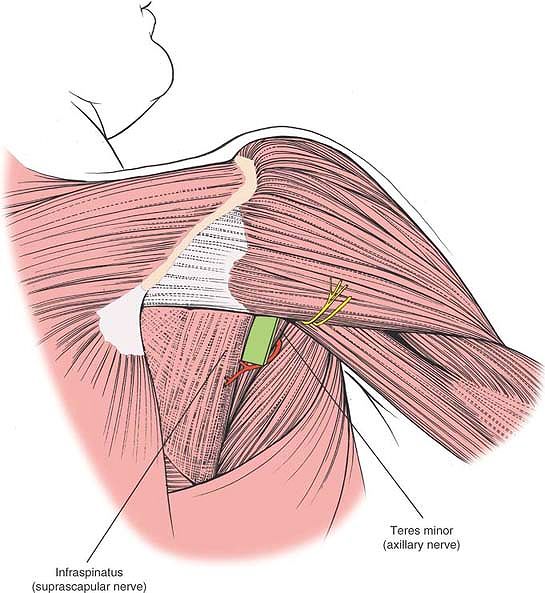 |
|
Figure 1-58 The internervous plane lies between the teres minor (axillary nerve) and the infraspinatus (suprascapular nerve).
|
passes around the base of the spine of the scapula as it runs from the
supraspinous fossa to the infraspinous fossa. It is the nerve supply
for both the supraspinatus and infraspinatus muscles. The infraspinatus
must not be retracted forcefully too far medially during the approach
because a neurapraxia may result from stretching the nerve around the
unyielding lateral edge of the scapular spine (see Fig. 1-67).
runs with the axillary nerve in the quadrangular space beneath the
inferior border of the teres minor muscle. Damage to this artery leads
to hemorrhaging that is difficult to control. This danger can be
avoided by staying in the correct intermuscular plane (see Fig. 1-66).
split the detached deltoid muscle at the lateral edge of the wound. To
gain better access to the posterior
aspect
of the shoulder joint, detach the infraspinatus 1 cm from its insertion
onto the greater tuberosity of the humerus. Retract the muscle
medially, taking care not to damage the suprascapular nerve, which
enters the undersurface of the muscle just below the spine of the
scapula. Such an exposure is necessary for correct placement of a
posterior bone block (Fig. 1-64). Even with care neurapraxias of the suprascapular nerve are not uncommon following this maneuver.
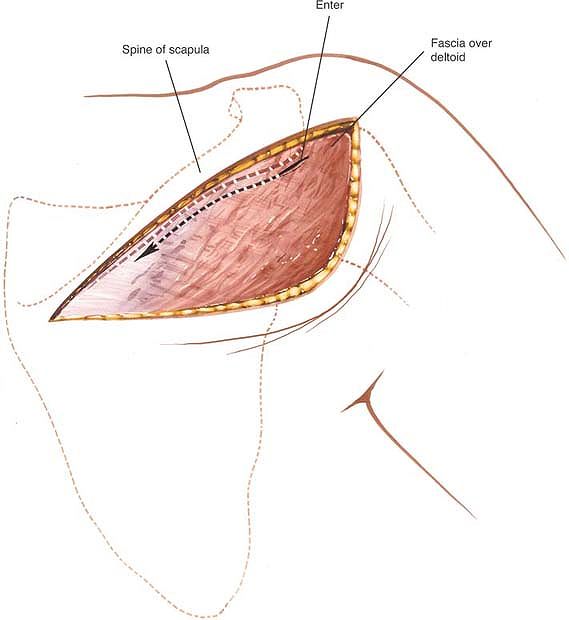 |
|
Figure 1-59
Identify the origin of the deltoid muscle, the spine of the scapula, and the attachment from its origin. Begin detaching the muscle from the lateral to the medial point. |
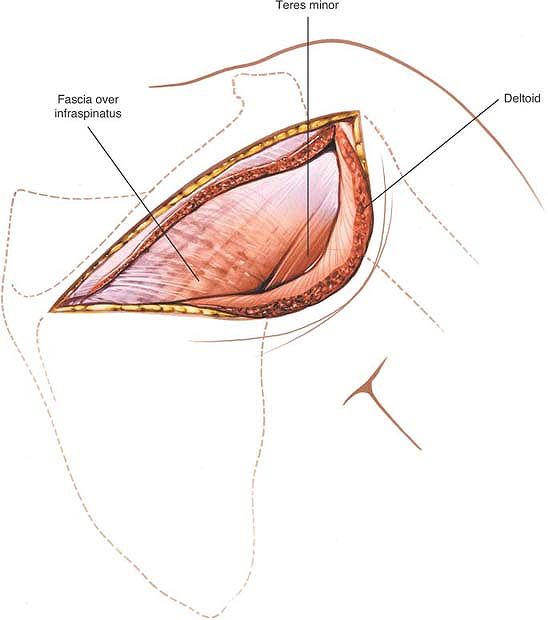 |
|
Figure 1-60 Identify the internervous plane between the infraspinatus and teres minor. Note that it is difficult to define.
|
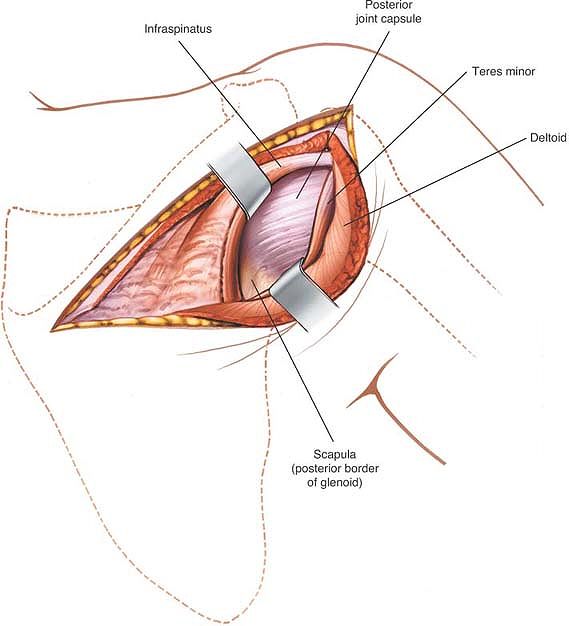 |
|
Figure 1-61
Retract the infraspinatus superiorly and the teres minor inferiorly to reach the posterior aspect of the joint capsule of the shoulder. |
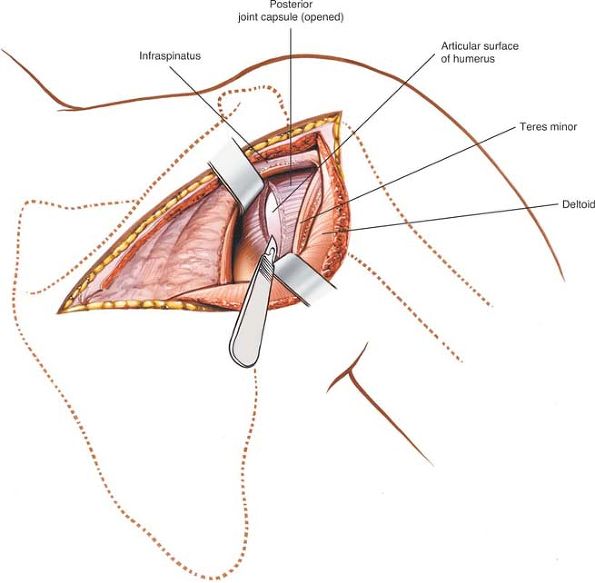 |
|
Figure 1-62 Incise the joint capsule close to the glenoid cavity.
|
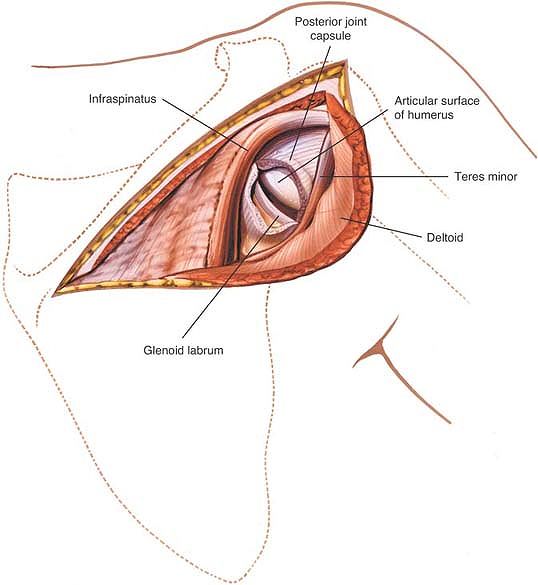 |
|
Figure 1-63
Retract the joint capsule to reveal the posterior regions of the glenoid cavity, the neck of the scapula, and the head of the humerus. |
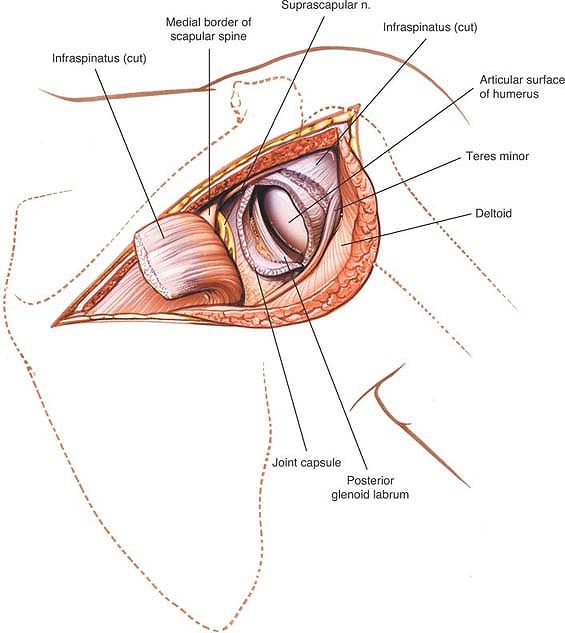 |
|
Figure 1-64
To gain greater exposure of the joint, cut the infraspinatus muscle close to its attachment to the humerus and retract it medially. Be careful to retract the muscle gently to avoid stretching the suprascapular nerve, which enters the muscle on its undersurface. |
anterior and lateral aspects, is covered by two muscular sleeves. The
posterior part of the deltoid muscle forms the outer sleeve of muscle,
as it does for all other approaches to the shoulder joint. The inner
sleeve consists of two muscles of the rotator cuff, the infraspinatus,
and the teres minor (Figs. 1-65 and 1-66).
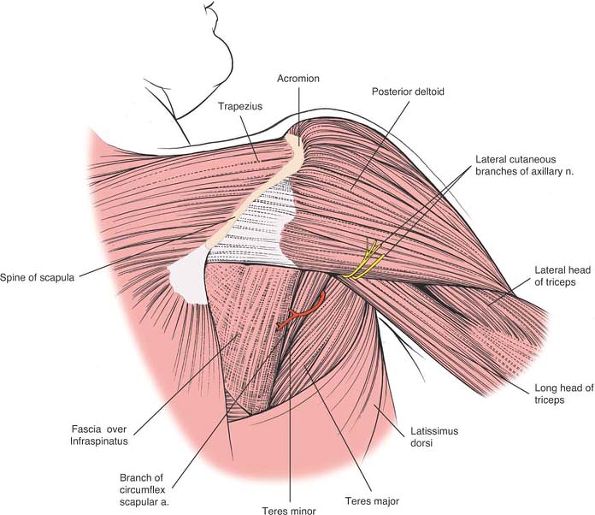 |
|
Figure 1-65
The superficial muscles of the posterior aspect of the shoulder. The posterior portion of the deltoid as it takes origin from the spine of the scapula is aponeurotic, and the plane between it and the underlying infraspinatus is difficult to identify. |
a thick, bony ridge projecting from the back of the blade of the
scapula. Its base runs almost horizontally, and its free lateral border
curves forward to form the acromion. The spine separates the
supraspinous fossa from the infraspinous fossa. The trapezius muscle
inserts into it from
above; part of the deltoid muscle originates from its inferior border (see Fig. 1-65).
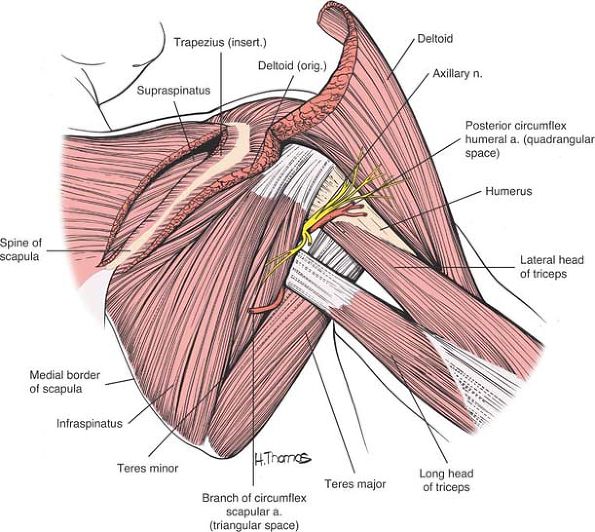 |
|
Figure 1-66
The posterior portion of the deltoid is detached from the spine of the scapula, revealing the infraspinatus, teres minor, and teres major muscles, as well as the long and lateral heads of the triceps muscle. The boundaries of the quadrangular space are, superiorly, the lower border of the teres minor; laterally, the surgical neck of the humerus; medially, the long head of the triceps; and, anteriorly, the upper border of the teres major. Through this space run the axillary nerve and the posterior circumflex humeral artery. Infraspinatus. Origin. Medial three fourths of infraspinous fossa of scapula. Insertion. Central facet on greater tuberosity of humerus. Action. Lateral rotator of humerus. Nerve supply. Suprascapular nerve.
Teres Minor. Origin. Axillary border of scapula. Insertion. Lowest facet on greater tuberosity of humerus. Action. Lateral rotator of humerus. Nerve supply. Axillary nerve.
|
lines of cleavage of the skin, the resultant scar usually is broad. A
vertical incision at the lateral end of the scapular spine is more
cosmetic, but provides poor exposure of the joint.
deltoid muscle that arise from the spine of the scapula are detached.
Because the fibers are straight and blend intimately with the
periosteum of the scapula, the muscle can be removed subperiosteally.
During closure, the good, tough tissue that remains attached to the
muscle provides an excellent anchor for sutures, in contrast to the
anterior and lateral portions
of the muscle. Drill holes may need to be placed through the spine, however, to anchor the muscular sutures.
the back of the shoulder joint; a small bursa lies between the muscle
and the posterior aspect of the scapular neck to help the tendon glide
freely over the bone. The muscle also inserts into the capsule of the
shoulder joint, mechanically increasing the capsule’s strength (Fig. 1-67).
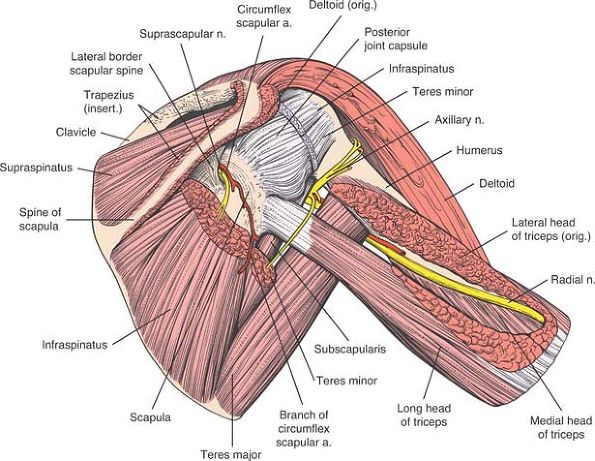 |
|
Figure 1-67
The lateral portion of the infraspinatus and the teres minor has been removed to reveal the joint capsule. The suprascapular nerve and the circumflex scapular artery are seen curving medially and distally around the lateral border of the spine of the scapula. The axillary nerve is seen emerging through the quadrangular space and splitting into many branches. The medial branch splits to supply the teres minor muscle. The radial nerve is seen crossing through the triangular space and entering the spiral groove in the upper portion of the humerus. The triangular space is formed superiorly by the lower border of the teres major muscle, medially by the long head of the triceps, and laterally by the shaft of the humerus. |
infraspinatus. Its fibers run parallel with one another, in contrast to
the multipennate fibers of the infraspinatus; this difference may help
in identification of the interval between the two muscles.
border. The superior border (the boundary between the infraspinatus and
teres minor muscles), therefore, is the safe side of the muscle and a
true internervous plane (see Fig. 1-66).
branch of the posterior cord of the brachial plexus. It runs down along
the posterior wall of the axilla on the surface of the subscapularis,
far from the incision made in that muscle during the anterior approach
to the shoulder (see Fig. 1-26). The nerve
then runs through the quadrangular space, where it touches the surgical
neck of the humerus. At that point, it can be damaged easily by
surgery, by fractures of the surgical neck of the humerus, or by
anterior dislocation of the shoulder.
boundaries from the posterior view are as follows: superiorly, the
lower border of the teres minor; laterally, the surgical neck of the
humerus; medially, the long head of the triceps; and inferiorly, the
upper border of the teres major.
boundaries from the anterior view are as follows: superiorly, the
subscapularis; laterally, the surgical neck of the humerus; medially,
the long head of the triceps; and inferiorly, the upper border of the
teres major (see Fig. 1-26).
of the subscapularis and, after traversing the quadrangular space,
emerges in the back of the shoulder beneath the lower border of the
teres minor. The posterior circumflex humeral vessels run with it (see Fig. 1-66).
damage the axillary nerve; however, if the dissection strays out of the
correct plane and below the teres minor, the axillary nerve can be
damaged. Because the axillary nerve is the sole nerve supply to the
deltoid muscle, any damage will produce severe functional impairments.
divides into two branches after giving off a twig to the shoulder
joint. The deep branch enters and supplies the deep surface of the
deltoid (see Fig. 1-66). The superficial
branch supplies the teres minor muscle and sends a cutaneous branch to
the lateral aspect of the upper arm, namely, the upper lateral
cutaneous nerve of the arm, which supplies the skin over the insertion
of the deltoid muscle (see Fig. 1-65).
clinical importance in cases of traumatic axillary nerve palsy
following, for instance, an acute anterior dislocation of the shoulder.
Examination of the paralyzed deltoid and teres minor muscles may be
difficult or impossible because of the pain that follows this injury.
Diminution of sensation over the insertion of the deltoid is good
presumptive evidence of the presence of an axillary nerve palsy.
which states that the motor nerve to a muscle tends to send a branch to
the joint that the muscle moves and another branch to the skin over the
joint.28 Pain in the shoulder is
perceived via the axillary nerve and, therefore, may be referred to the
cutaneous distribution of that nerve.
posterior cord of the brachial plexus, leaves the axilla by passing
backward through a triangular space that is defined superiorly by the
lower border of the teres major, laterally by the shaft of the humerus,
and medially by the long head of the triceps (see Figs. 1-66 and 1-67).
approach are remote. It cannot be damaged during the posterior approach
to the shoulder unless the correct plane is deviated from
substantially, below not only the teres minor but the teres major as
well.
sleeve of shoulder muscles is viewed from the back. Its boundaries are
as follows: superiorly, the lower border of the teres minor; laterally,
the long head of the triceps; and inferiorly, the upper border of the
teres major (see Fig. 1-66).
vessels, which form part of the extremely rich blood supply to the
scapula. Dissection carried out between the teres minor and teres major
muscles should not be carried out in elective surgical procedures
because of damage to these vessels, causing profuse hemorrhage that is
difficult to control (see Fig. 1-66). Because
the scapula has such a rich blood supply, fractures of the scapula are
often associated with profuse blood loss. The hematoma is constrained
within the fascia surrounding the scapula muscles and is not obvious.
Potential blood loss from a fractured scapula always must be considered
during vascular assessment of a polytraumatized patient.
approaches is straightforward. If a given structure is not visible, it
may be exposed by extending the incision, thus expanding the surgical
approach. By contrast, visualization of structures in arthroscopic
approaches is achieved by using a telescope. The most commonly used
arthroscope is angulated 30° at its tip so that the view obtained shows
the structures that are 30° from the long axis of the arthroscope and
not the structures that are directly in front of the scope. This is the
arthroscope described in this book (Fig. 1-68, inset).
the joint allows the arthroscope to be placed only in certain
positions. The use of an angled scope allows the surgeon to see “around
the corner” and thereby greatly increases the view obtained within any
joint.
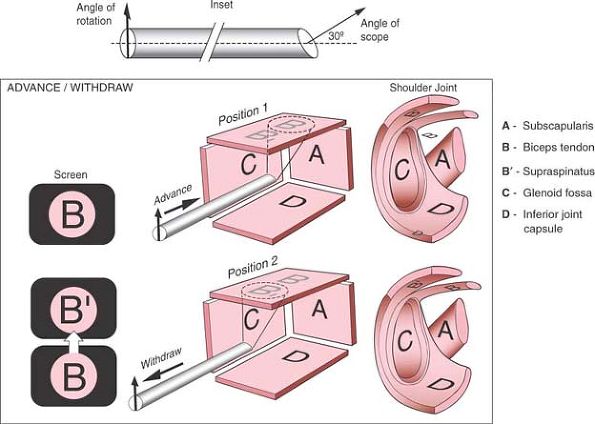 |
|
Figure 1-68
Visualization of structures using an arthroscope is achieved in several ways. Moving the arthroscope forward and backward (advancing or withdrawing) will show you structures in front of or behind your original view. Withdrawing the arthroscope from Position 1 to Position 2 changes the view from B to B′. Because the tip of the scope is angled at 30° from its axis, it is not possible to zoom in on an object merely by advancing the scope. |
achieved in several ways. Moving the scope forward or backward
(advancing or withdrawing it) will reveal structures in front of or
behind the original view (see Fig. 1-68). Keep the following important points in mind during arthroscopic use:
-
Because the scope is angled 30° from its axis, it is not possible to zoom in on an object merely by advancing the scope.
-
Rotating the arthroscope will reveal a series of views angled at 30° from the axis of the scope (Fig. 1-69).
-
Angling the scope will change the direction of the view (Fig. 1-70). You will not be able to visualize those structures directly in front of the arthroscope unless you angle it.
-
It is possible to change the view by
moving the joint while leaving the arthroscope in the same position.
This maneuver is vital for full inspection of any joint.
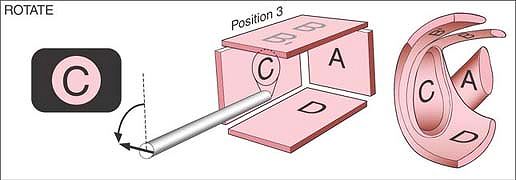 |
|
Figure 1-69
Rotating the scope will provide a series of views at angles of 30° from the axis of the scope. Rotating the arthroscope 90° counterclockwise from Position 2 to Position 3 changes the view from B′ to C. |
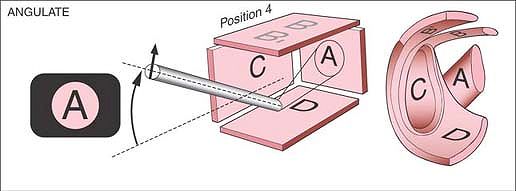 |
|
Figure 1-70
Angling the scope changes the direction of the view. It is the only way to be able to visualize those structures directly in front of the scope. Angling the arthroscope from Position 2 to Position 4 changes the view from B′ to A. |
with a generous capsule that allows a large range of movement in all
planes. Therefore, the anatomy of the joint makes it ideal for
arthroscopic approaches. However, the shoulder is covered by thick
layers of muscles, and this can make arthroscopic approaches somewhat
difficult (Figs. 1-71 and 1-72).
Neurovascular structures also are potentially at risk in arthroscopic
approaches to the shoulder. The presence of the main neurovascular
bundle anteroinferior to the joint limits anterior approaches. Other
neurovascular structures may also be at risk if the entry portals are
inaccurately positioned (see Dangers).
-
Arthroscopic subacromial decompression for chronic rotator cuff tendonitis
-
Treatment of partial thickness tears of the rotator cuff
-
Treatment of tears of the glenoid labrum
-
Treatment of degenerative disease of the acromioclavicular joint
-
Removal of loose bodies
-
Treatment of osteochondritis dissecans
-
Synovectomy
shoulder arthroscopy surgery. The posterior portal is the one most
commonly used for diagnostic purposes. It is nearly always used in
conjunction with the anterior portal. The combination of these
approaches allows the use of the arthroscope along with arthroscopic
instrumentation. Usually the arthroscope is inserted via the posterior
portal, and instruments are inserted via the anterior portal. However,
either portal can be used for either purpose. These two approaches are
described in this section.
the upper half of the table 60°. Position the patient so that the
operative shoulder is off the edge of the table, allowing access to
both sides of the shoulder (Fig. 1-73). Prep and drape the arm so that it can be
freely manipulated during arthroscopy. This position, known as the beach chair position,7
reduces venous pressure around the shoulder and reduces bleeding. Arm
traction is useful in arthroscopic subacromial decompression but is not
necessarily for diagnostic arthroscopy.
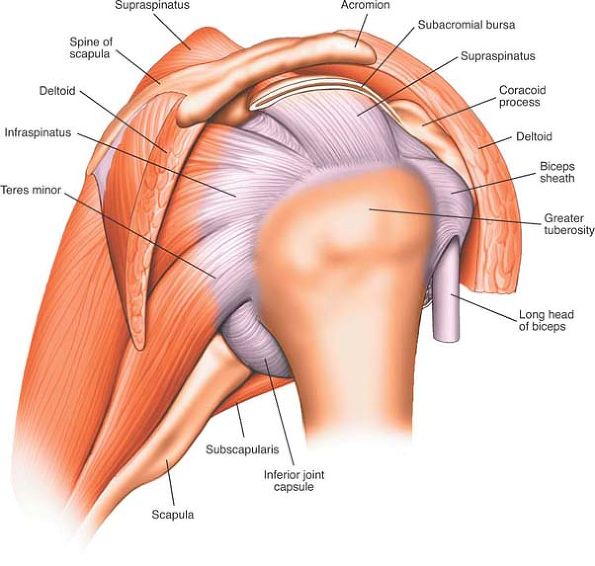 |
|
Figure 1-71
Anatomy of the shoulder joint. Lateral view of the right shoulder with the lateral aspect of deltoid muscle removed, showing the thick muscular covering of the joint. |
form one continuous arch. The bony dorsum and lateral aspect of the
acromion are easy to palpate on the outer aspect of the shoulder (see Figs. 1-46, 1-48, and 1-54A).
drop your fingers distally about 1 in. from the anterior edge of the
lateral one third of the clavicle. Press laterally and posteriorly in
an oblique line until you feel the coracoid process.
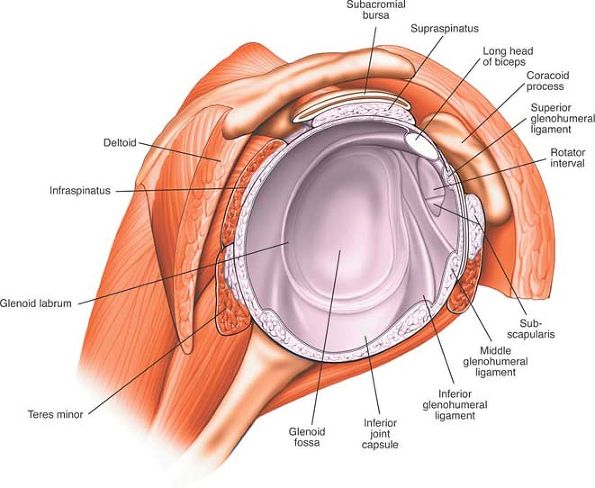 |
|
Figure 1-72 Lateral view of glenoid cavity with the humeral head removed.
|
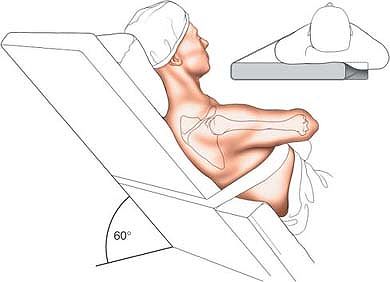 |
|
Figure 1-73
Position of the patient for arthroscopy. Elevate the upper half of the table 60°. Position the patient so that the operative shoulder is off the edge of the table, allowing access to both sides of the shoulder. This is known as the “beach chair” position.7 |
muscle (supplied by the axillary nerve) and the infraspinatus muscle
(supplied by the suprascapular nerve) (see Fig. 1-71).
muscle (supplied by the medial and lateral pectoral nerves) and the
deltoid (supplied by the axillary nerve) (see Fig. 1-8).
trochar and arthroscopic sheath through the posterior skin incision,
aiming the tip of the arthroscope toward your finger (Fig. 1-76).
You will enter the glenohumeral joint at a point just above its
equator. Although, in theory, the arthroscope may penetrate the rotator
cuff between the infraspinatus and teres minor, the scope usually
traverses through the substance of the infraspinatus (see Fig. 1-76).
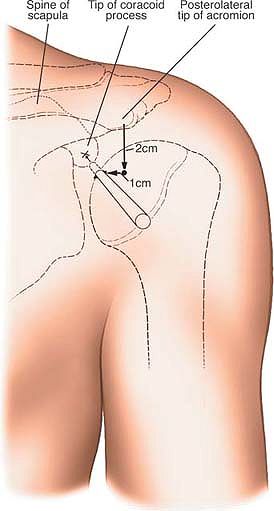 |
|
Figure 1-74 Posterior incision. Make an 8-mm stab incision 2 cm inferior and 1 cm medial to the posterior lateral tip of the acromion.
|
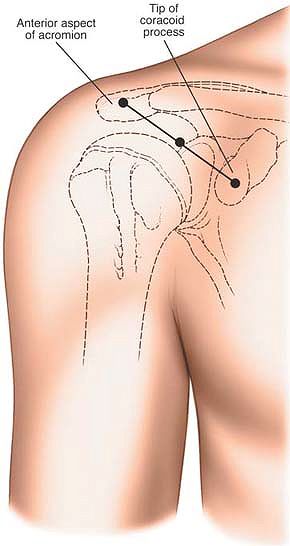 |
|
Figure 1-75
Anterior incision. Make an 8-mm stab incision halfway between the tip of the coracoid process and the anterior aspect of the acromion. |
insert the arthroscope through the posterior portal to allow you to
visualize the anterior capsule of the shoulder joint. Next, insert a
long hypodermic needle through the anterior skin incision and enter the
joint under direct vision of the arthroscope. This will ensure that you
enter the joint in a correct and safe position (Fig. 1-77).
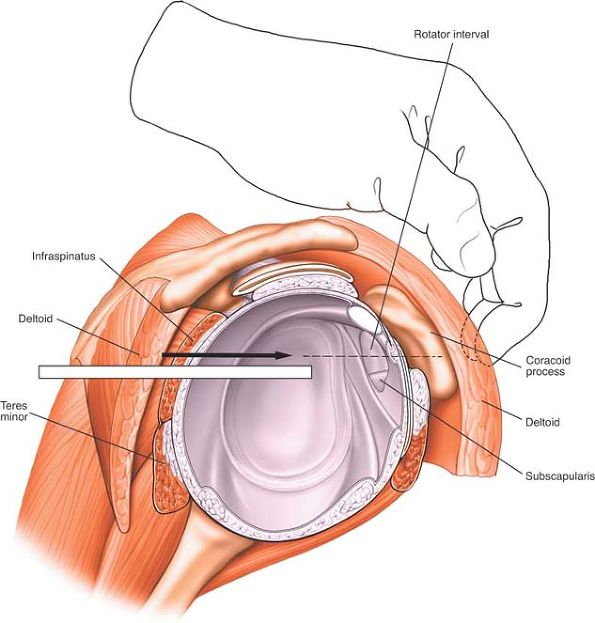 |
|
Figure 1-76
Posterior insertion of the arthroscope. Place your finger on the coracoid process. Insert the trochar and arthroscopic sheath through the posterior skin incision, aiming the tip of the arthroscope toward your finger. |
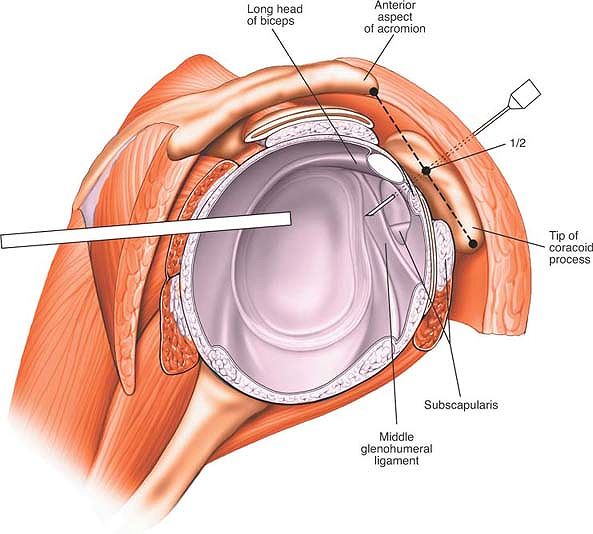 |
|
Figure 1-77
Anterior insertion of the arthroscope. Insert an arthroscope through the posterior portal to allow you to visualize the anterior capsule of the shoulder joint. Next, insert a long hypodermic needle through the anterior skin incision and enter the joint under direct vision of the scope. |
-
Insert a 30° arthroscope through the posterior incision (see Fig. 1-74).
-
Identify the biceps tendon and its origin as it runs from superior to inferior (Fig. 1-78A,B, View 1).
-
Next, rotate the arthroscope superiorly to allow visualization of the supraspinatus (Fig. 1-78A,B, View 2). The supraspinatus lies posterior to the biceps tendon.
-
To visualize infraspinatus and teres minor you will need to rotate not only the arthroscope but also the humeral head (Fig. 1-79A,B, View 3).
-
Next, note the anterior triangle of the
shoulder, formed by the biceps tendon, the superior edge of the
subscapularis, and the glenoid (Fig. 1-80A,B, View 4; see Fig. 1-78A,B, View 1). This triangle marks the safe spot for entry through the anterior portal (see Fig. 1-77). -
Pass the arthroscope to the upper
anterior margin of the glenoid and rotate the scope inferiorly to allow
examination of the anterior glenohumeral complex (Fig. 1-80A,B, View 5).
You may need to apply a distraction force to the shoulder at that time,
or alternatively use a 70° rather than a 30° telescope.P.66![]() Figure 1-78 (A) Lateral view of the shoulder joint with the scope in place (right), correlated with their respective arthroscopic views (left).
Figure 1-78 (A) Lateral view of the shoulder joint with the scope in place (right), correlated with their respective arthroscopic views (left).
View 1: Insert the arthroscope through a posterior approach and
identify the biceps tendon. Identify the long head of biceps as it runs
superiorly to its origin. Note the position of the arthroscope in the
joint and the view obtained. View 2: Rotate the arthroscope superiorly
to visualize the rotator cuff. Observe the supraspinatus portion of the
rotator cuff. (B) Overall views of the shoulder joint seen from the direction of the arthroscope in Views 1 and 2 (left), correlated with their respective arthroscopic views (right).P.67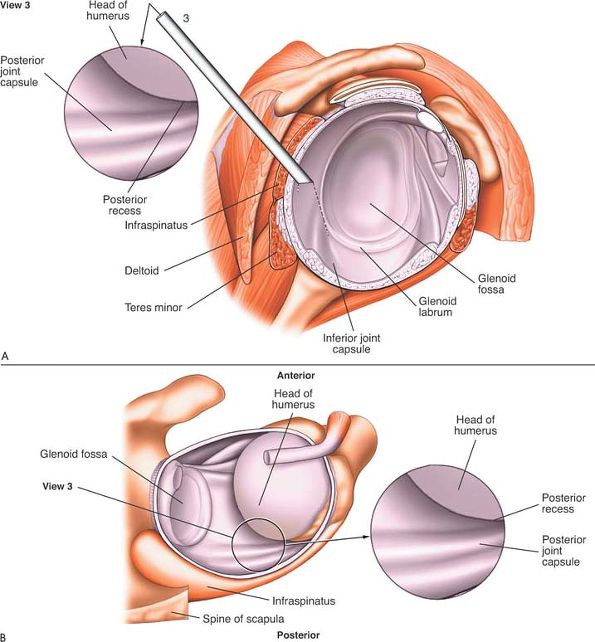 Figure 1-79 (A) Lateral view of the shoulder joint with the scope in place (right), correlated with its arthroscopic view (left).
Figure 1-79 (A) Lateral view of the shoulder joint with the scope in place (right), correlated with its arthroscopic view (left).
View 3: Rotate the arthroscope to look inferiorly and identify the
inferior portion of the rotator cuff (infraspinatus and teres minor).
Rotate the humeral head to visualize the infraspinatus tendon. (B) Overall view of the shoulder joint seen from the direction of the arthroscope in View 3 (left), correlated with its arthroscopic view (right).P.68![]() Figure 1-80 (A) Lateral views of the shoulder joint with the scope in place (right), correlated with their respective arthroscopic views (left).
Figure 1-80 (A) Lateral views of the shoulder joint with the scope in place (right), correlated with their respective arthroscopic views (left).
View 4: Advance the arthroscope anteriorly and identify the anterior
triangle. Observe the anterior triangle formed by the biceps tendon,
the superior edge of subscapularis, and the glenoid labrum. View 5:
Pass the arthroscope to the upper margin of the glenoid and rotate the
arthroscope inferiorly. Observe the anterior glenohumeral complex. View
6: Pass the arthroscope anteriorly and then rotate it to allow you to
look inferiorly. Observe the space underlying the subscapularis. Direct
the arthroscope inferiorly and then rotate it to look posteriorly. (B) Overall views of the shoulder joint seen from the direction of the scope in Views 4, 5, and 6 (left), correlated with their respective arthroscopic views (right). -
Pass the arthroscope anteriorly into the
anterior triangle and rotate the scope so as to allow you to look
inferiorly into a space underlying the subscapularis (Fig. 1-80A,B, View 6). This space is a frequent site for loose bodies. -
Next, redirect the arthroscope inferiorly
and rotate the telescope posteriorly to allow access to the posterior
recess of the shoulder (Fig. 1-81A,B, View 7; see Fig. 1-79).
Visualization of the humeral head and glenoid are easily accomplished
through the posterior portal. Careful manipulation of the shoulder is
required to visualize the whole of the articular surface.
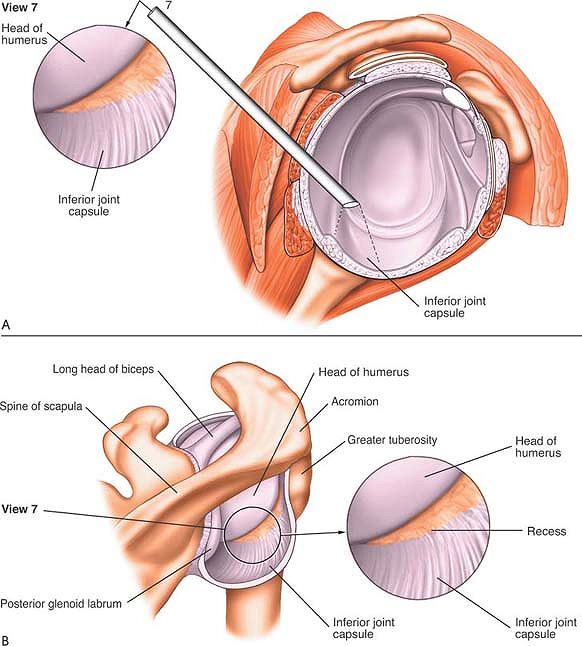 |
|
Figure 1-81 (A) Lateral view of the shoulder joint with the scope in place (right), correlated with its arthroscopic view (left).
View 7: Direct the arthroscope inferiorly and then rotate it to look posteriorly. Observe the posterior recess of the shoulder. (B) Overall view of the shoulder joint seen from the direction of the arthroscope in View 7 (left), correlated with its arthroscopic view (right). |
surface of the deltoid muscle, about 7 cm below the tip of the acromion (see Figs. 1-26, 1-36, 1-47, and 1-66).
If the posterior portal is correctly located with regard to the
posterolateral tip of the acromion, this portal should lie about 3 cm
superior to the nerve. Only a very inferiorly placed incision will
endanger the nerve.
nerve supplied to both the supraspinatus and infraspinatus, runs around
the base of the spine of the scapula as it runs from the supraspinatus
fossa to the infraspinatus fossa (see Figs. 1-53 and 1-67).
This nerve is at risk if the posterior portal is made too medially. The
correctly positioned portal is approximately 2 cm lateral to the nerve.
the nerve supply of the flexor muscles of the upper arm, enters those
muscles some 2 cm to 8 cm distal to the tip of the coracoid process.
The nerve, therefore, is unlikely to be damaged by a portal made
superior and lateral to the level of the coracoid process (see Figs. 1-13, 1-21, and 1-25).
lie along the medial side of the coracoacromial ligament and will not
be endangered through the classic anterior portal. Branches of the
artery will, however, be damaged by more superior approaches used to
enter the subacromial space.
to access the subacromial space, withdraw the arthroscope from the
shoulder; using the same skin incision, redirect the scope more
superiorly to run on the underside of the acromion. To do this you will
need to create a separate arthroscopic penetration of the deltoid
muscle. Access to the subacromial space is often difficult due to
disease processes, especially of the subacromial bursa. Continuous
traction is indicated. Bleeding is frequently encountered.
AW: Spontaneous dislocation and destruction of tendon of long head of
biceps brachii: fifty-nine instances. Arch Surg 17:493, 1928
HH, Bechitol CO: Painful shoulder: observations on the role of the
tendon of the long head of the biceps brachii in its causation. J Bone
Joint Surg [Am] 30:263, 1948
Palma AF, Callert G, Bennett GA: Variational anatomy and degenerative
lesions of the shoulder joint. Instr Course Lect 6:255, 1949
MT, Tocantins LM: An anatomical study of the role of the long thoracic
nerve and the related scapular bursa in the pathogenesis of local
paralysis of the serratus anterior muscle. Anat Rec 71:375, 1938
J, Patte D, Elmeuk E: Repair of rupture of the rotator cuff of the
shoulder, with a note on the advancement of the supraspinatus muscle. J
Bone Joint Surg [Br] 47:36, 1965
DJ Jr: Treatment of recurrent posterior dislocation of the shoulder by
glenoplasty: report of three cases. J Bone Joint Surg [Am] 49:471, 1967
J: Lectures on rest and pain. In: WH Jacobson (ed). Joint innervation:
reflex control of muscles activating joints, 6th ed. London, G Bell,
1950:156.
MR, Crosby LA, Stafford P et al: Effects of plate location and
selection on the stability of midshaft clavicle osteotomies: a
biomechanical study. J Shoulder Elbow Surg 11: 457, 2002
P, Blauth M, Schneider C et al: Fractures of the glenoid treated by
operation: 5 to 23 year follow up of 22 cases. J Bone Joint Surg [BR]
84:173, 2002
JM, De Pew AD: Arthroscopic sub-acromial decompression and rotator cuff
debridement for stage II and stage III impingement. Arthroscopy 10:61,
1994
MJ, Altchek DW, Warren RF et al: Shoulder arthroscopy with the patient
in the beach chair position. Arthroscopy 4:256, 1988
JE, Levy HJ, Lemak LJ: Arthroscopic sub-acromial decompression in the
treatment of full thickness rotator cuff: a 3- to 6-year follow-up.
Arthroscopy 10:518, 1994

